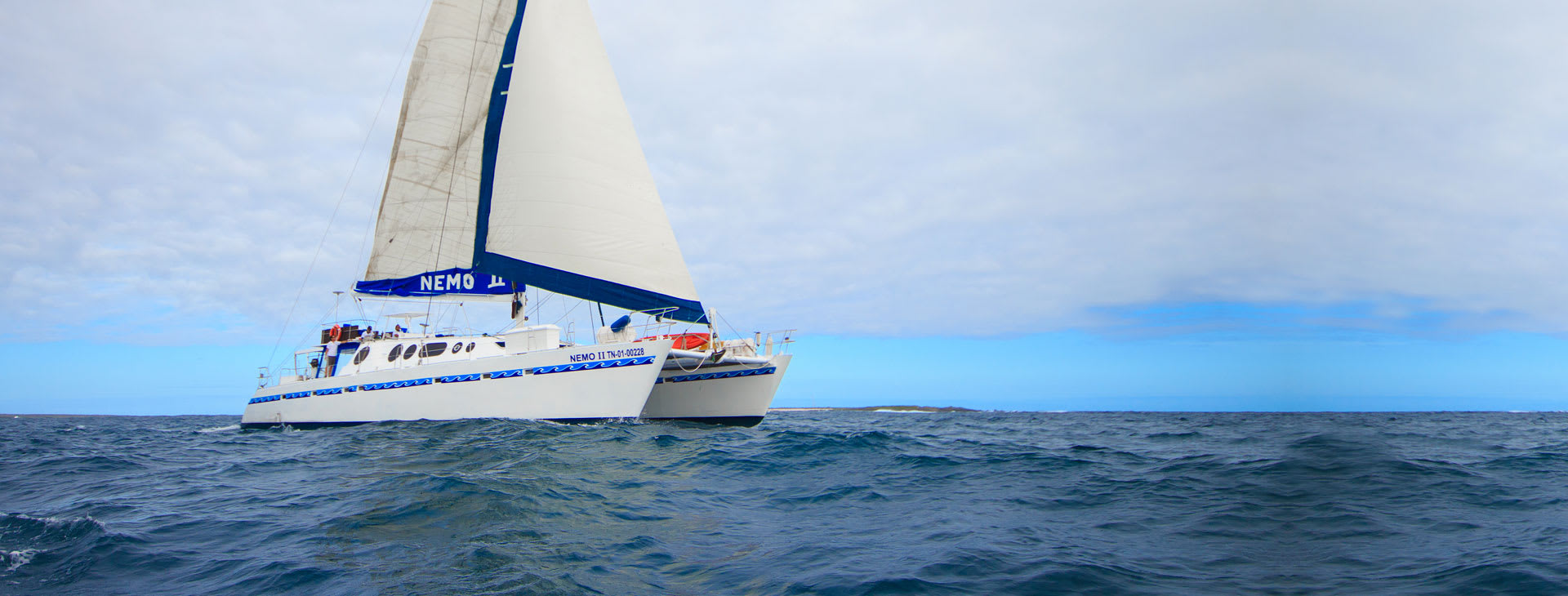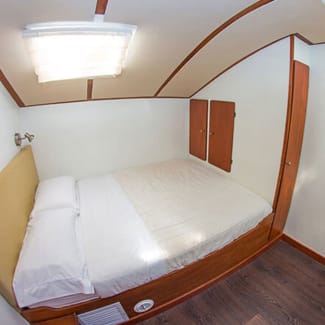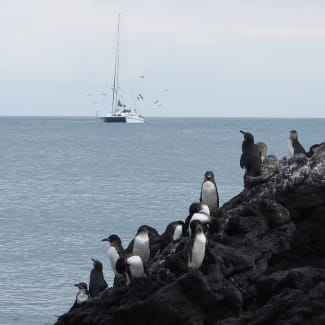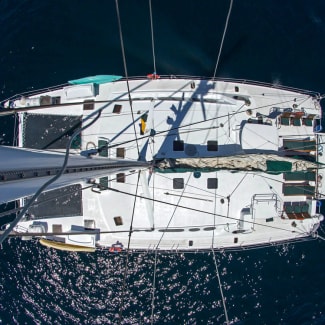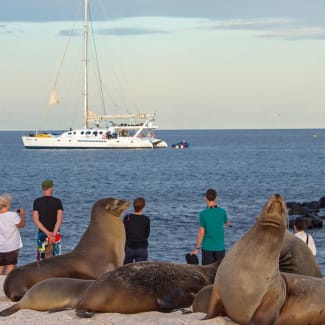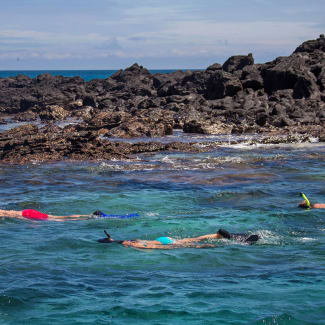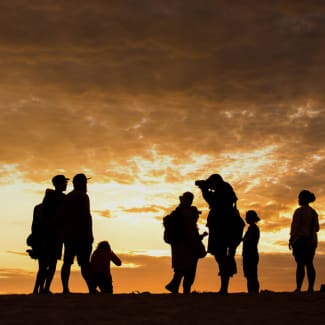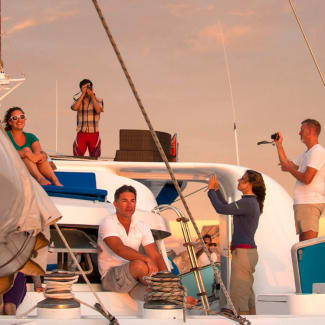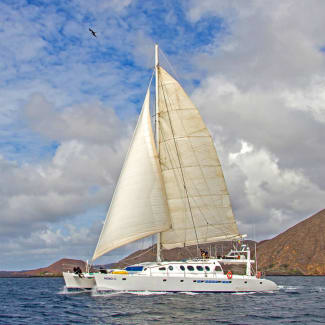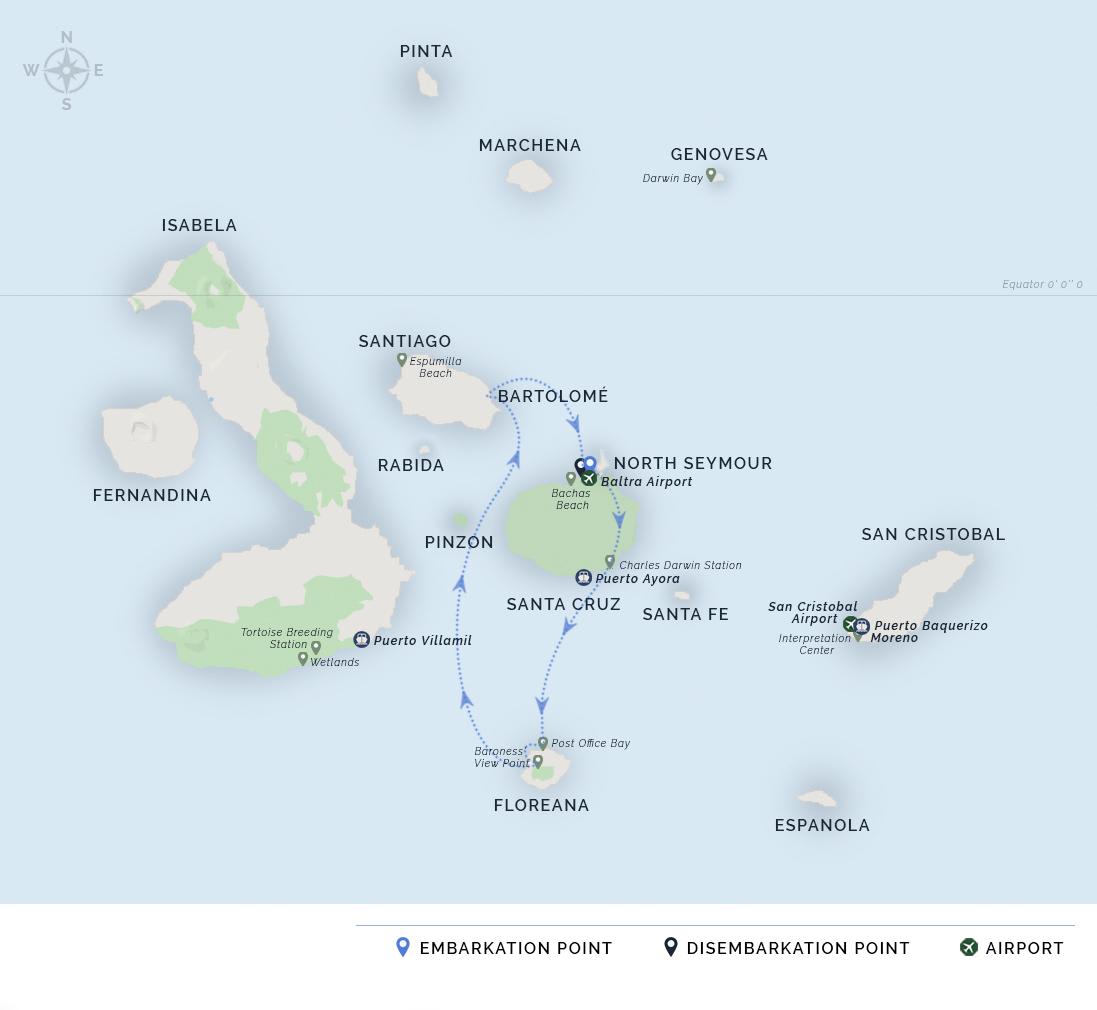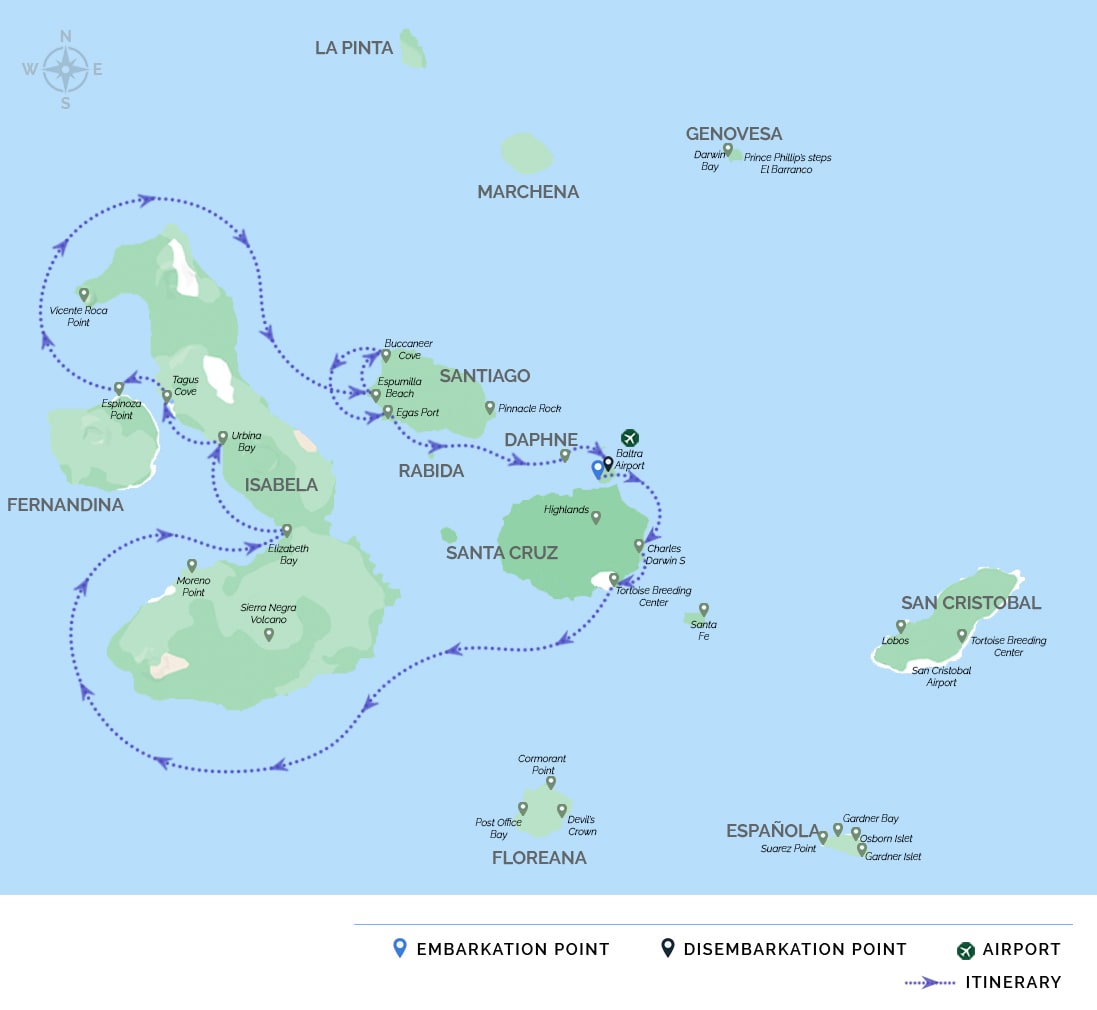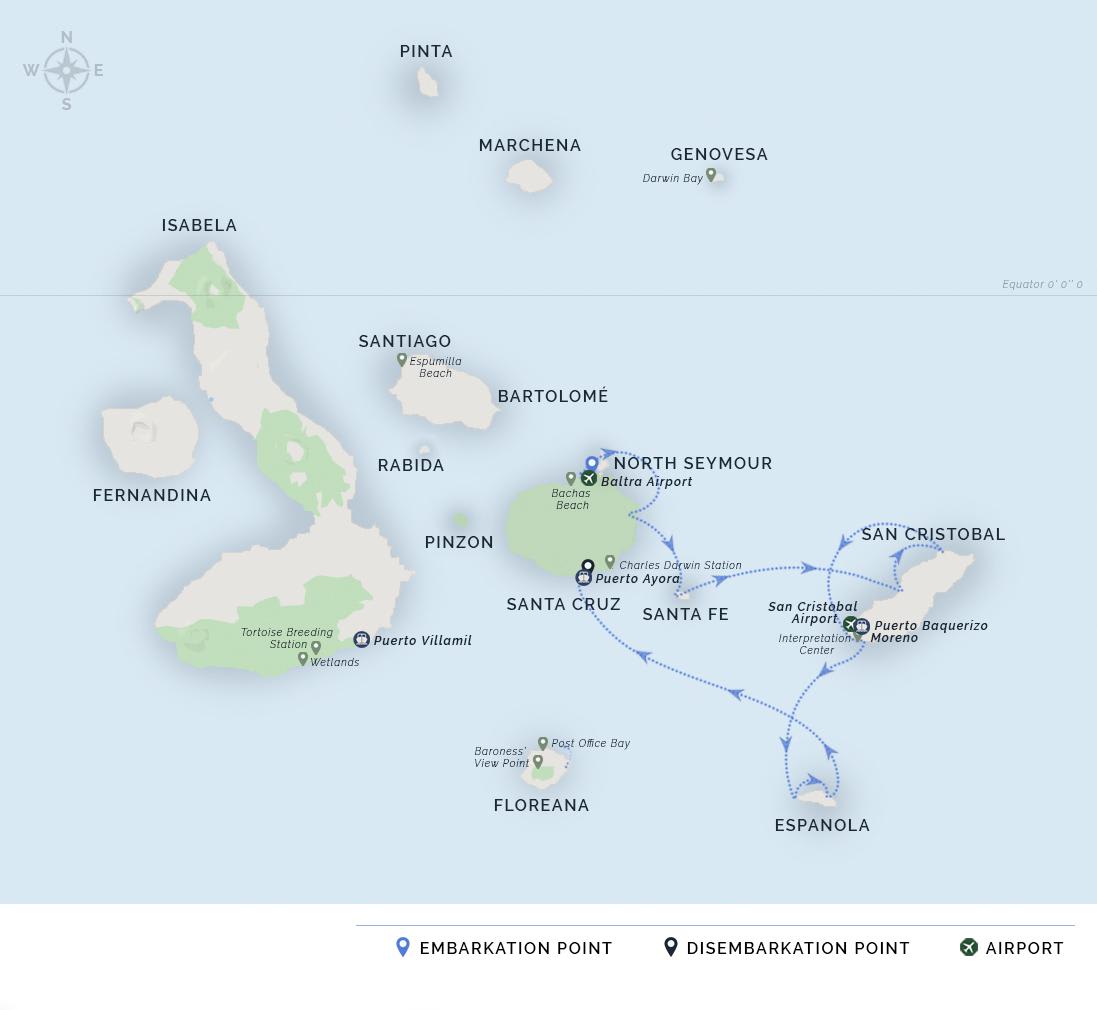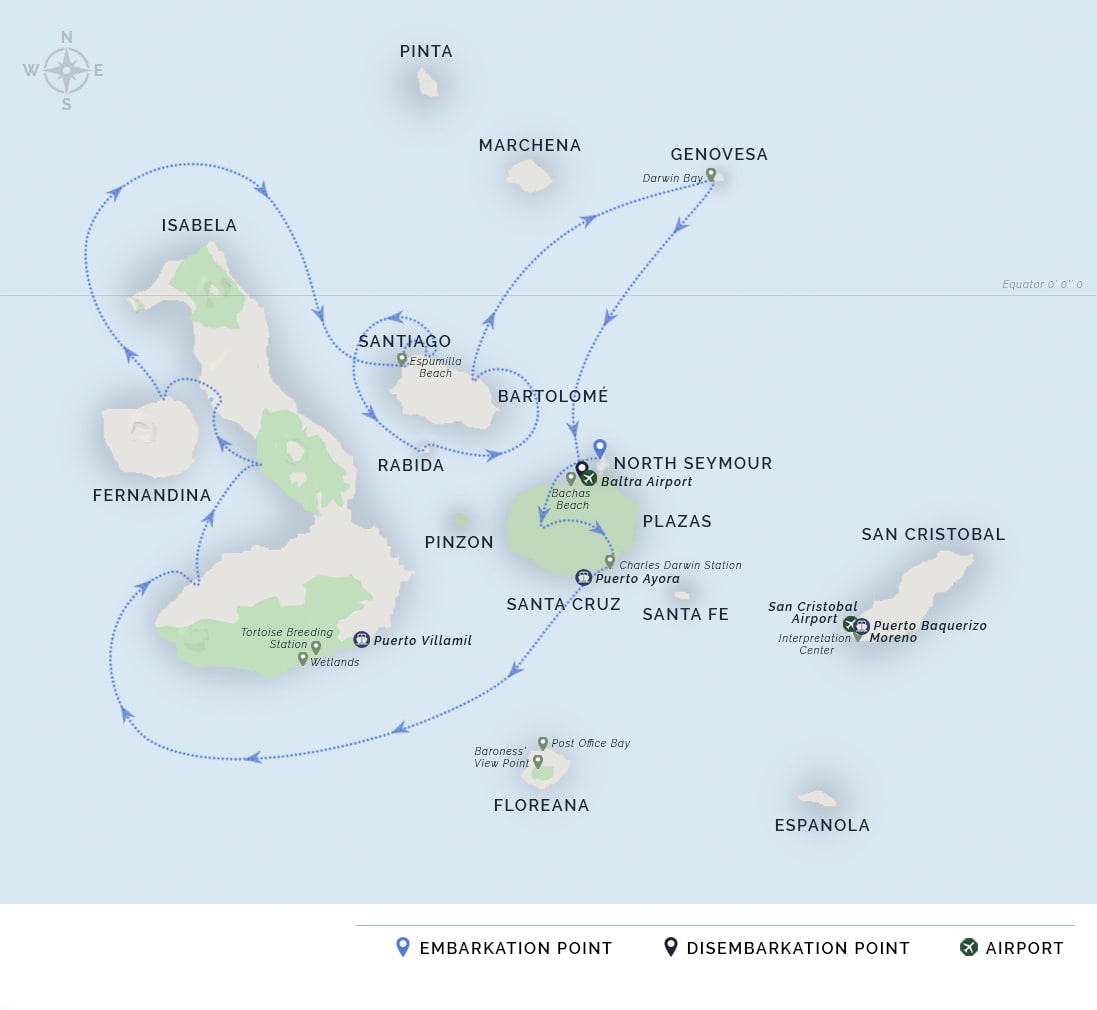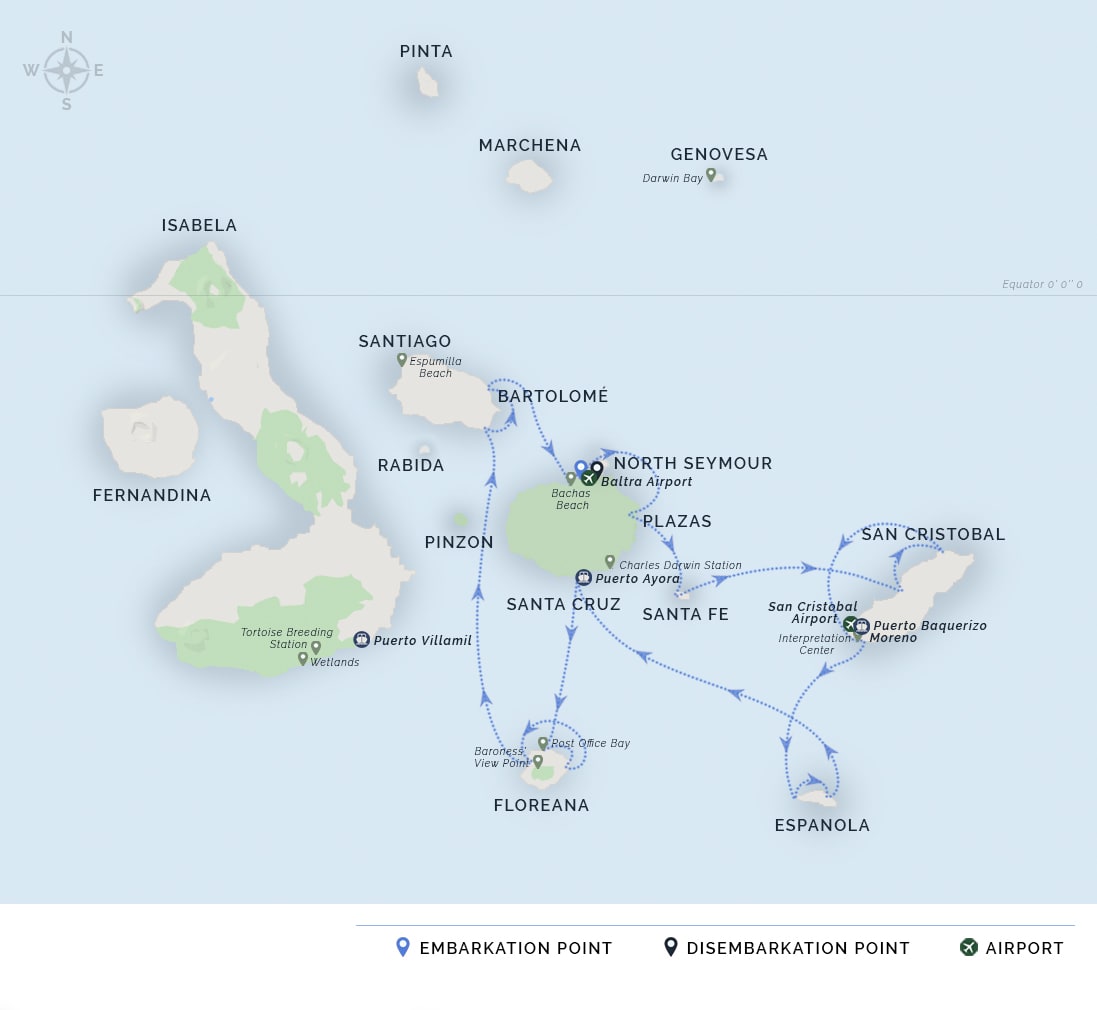Overview
Every day is a new adventure aboard the 72-foot sailing ship, the Nemo II. With seven cabins for 14 passengers, this twin-hulled catamaran pairs a yacht’s stability with the grace and romance of a sailboat.
Life Aboard The Nemo II Catamaran
As you set sail aboard the Nemo II, you will immediately feel a kinship with the other guests and the ship’s crew, as the experience of sailing together fosters a close-knit, family atmosphere. Settle into a chair on the sun deck to watch as birds fly nearby and dolphins escort you along your route. The alfresco dining area is the ideal spot to enjoy a snack or a casual meal between activities.
Indoors, a large saloon temps you out of the sun for educational presentations, and the well-stocked bar provides the perfect opportunity to enjoy a sundowner while reliving the day’s experiences with your fellow sailors. Watch as the crew unfurls the jib and hoists the mainsail to let the winds speed you to your next destination. Though the sails are used whenever possible, the ocean currents and wind conditions in the Galapagos often call for motor cruising, allowing you to arrive at your site in time for plenty of exploration.
Excursions From Your Nemo II Galapagos Cruise
The Nemo II sails along two eight-day itineraries. The northern route includes stops on Genovesa Island, where you may take a cliff hike searching for red-footed boobies and storm petrel colonies in their nesting sites. On Santiago Island, you may snorkel near playful sea lions and fur seals. To visit Floreana, Espanola, and San Cristobal Islands, select a cruise along the southern route.
A stop at Lobos Island, named after the large numbers of sea lions that make their home on the island, is a chance to see the nesting grounds of frigatebirds and blue-footed boobies. A stop on Santa Fe Island includes a dingy ride through a turquoise lagoon and a hike along a loop trail where you may see endemic land iguanas.
A True Sailing Experience
If you have ever dreamed of living aboard a sailboat, the Nemo II is your chance to experience the sailing lifestyle for yourself. The seven air-conditioned cabins feature a range of layouts, including double beds, twin bunks, and double bunks. Each cabin features a private wet-room-style bathroom and storage cupboards.
Though the accommodations may seem less grand than a luxury yacht, the Nemo II offers an authentic sailing experience that you won’t find on other vessels. Thanks to the variety of cabin layouts available, cruises aboard the Nemo II are available at several price points, which makes this ship a great option for intrepid travelers and also for groups looking for an affordable charter option.
For sailing through the Galapagos with the wind in your hair and exploring the Galapagos Islands with a low guest-to-guide ratio of 14:1, the Nemo II offers a charming way to explore the Galapagos.
Itineraries & Prices
All itineraries are subject to change due to seasonal weather conditions (and resultant variations in river and tributary water levels) affecting accessibility to locations. Thus navigation routes, times and excursions may need to be modified at the cruise captain’s or your guide's discretion.
Embarkation
AM: After arriving at Baltra airport you will be greeted by a representative of the vessel then board the Nemo II, enjoy a welcome drink, and have lunch.
PM: The name Bachas is “Spanglish” for 'barges' which were wrecked offshore during World War II. A common first landing site, there is a delightful swimming beach here, with a lagoon behind, and a longer beach for a stroll and wildlife watching. The saltwater lagoon behind often has great blue herons and small waders such as sander lings and semi‐palmated plovers. Both beaches are nesting areas for green sea turtles, which leave tracks in the sand to the back of the beach, especially from November to February. The beach offers ample space one can explore at leisure.

Darwin Bay & El Barranco
AM: Darwin bay, is the caldera of a collapsed volcano. We land on a small coral beach, were will take an easy walk. For those looking for a little more action there is a demanding optional walk over lava rock. This path will uncover stunning views from the cliffs with ample time and opportunity to photograph the amazing bird life. You may observe such species as swallow-tailed gulls, red-footed boobies, Nazca boobies, large ground finches, large cactus finches, sharp-billed ground finches, small marine iguanas, and great Frigatebirds.
PM: Also known as the bird island: El Barranco, this is a demanding walk up a steep cliff, where tropicbirds, red-footed boobies and other nesting seabirds can be found. We follow the trail through Palo Santo forest to a storm petrel colony passing red boobies and great Frigatebirds along the way.

Sullivan Bay & Rabida
AM: Breakfast service. Panga boat ride to Sullivan Bay. Wet landing. Nature walk. The main attraction of this bay is the broad, Pahoehoe, or rope lava flows. It is one of the most incredible places to compare the lava flows and their characteristics.
PM: Lunch and navigation to visit Rabida. One of the special features of Rabida Island is its remarkable red color, which is a result of the high percentage of oxidized iron in the composition of lava. Here we will witness the nine varieties of finches, as well as the large-billed flycatchers and brown pelicans. There is also a small salt-water lagoon where greater Flamingos can be seen and a beautiful colony of sea lions.
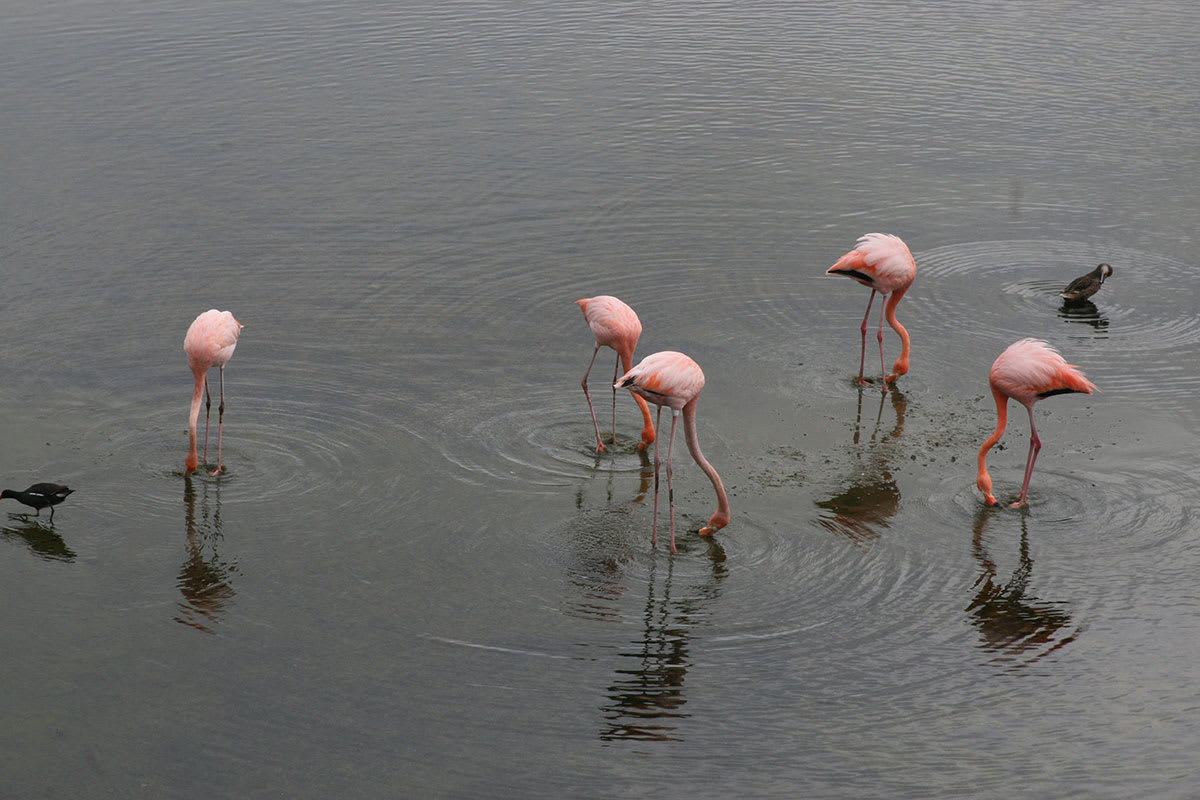
Disembarkation
AM: In the morning, enjoy the Highlands of Santa Cruz. This reserve offers you one of the best possibilities to see the huge turtles of Santa Cruz Island in their natural habitat. You can observe them from very close.
After your morning excursion, you will be assisted to Baltra airport for your flight to the mainland.

Embarkation
AM: Arrival at the airport in Baltra, reception with the cruise guide, and transfer to the yacht.
PM: Lunch service. Visit Charles Darwin Scientific Station and Breeding Center. The main visit to Puerto Ayora is to Charles Darwin Station. An excellent way to begin learning about the islands, their origin, and their formation. You will learn about how the Galapagos turtles are raised and meet George, the famous solitary turtle. The Scientific Station has a beach that receives many visitors on weekends. Dinner is served as we navigate to Floreana Island.
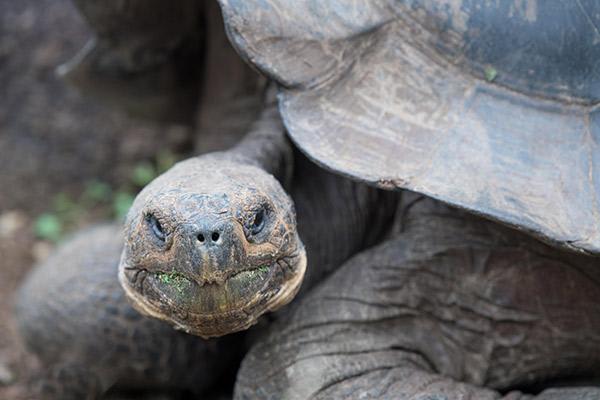
Cormorant Point, Champion Islet & Post Office Bay
AM: Breakfast service. Visit Floreana Island: Cormorant Point, Champion Islet, Baroness Viewpoint. Wet landing. Nature walk*. Possible activities: shallow water snorkeling, kayaking, panga boat exploration rides. The visit to Cormorant Point offers two contrasting beaches. Arriving on shore you will encounter a green sand beach (the green sand is caused by the olivine crystals derived silicates or magnesium and iron). From here you will follow the trail leading to a lagoon where Pink Flamingoes and other shorebirds can be seen in the distance making their home. If you look closely at the mud of this lagoon, there appear to be 'cracks' in the mud. These cracks are not caused by dryness but are actual flamingo footpaths. This is also a good spot for seeing Large‐Billed Flycatchers, Small‐Ground Finches, Medium‐Ground Finches, or Cactus Finches.
The walk continues to another beach on the other side made of fine white sand particles known as "Flour Beach". In the waters, Ghost Crabs and Rays can be seen swimming. Time and weather permitting you may even go for a swim or a snorkel. Other activities include a panga ride to Champion Point and kayaking at Baroness Viewpoint.
PM: Lunch service. Panga boat ride to Post Office Bay. Wet landing. Nature walk. Snorkeling from the beach. Arriving at Post Office Bay you will land on a brown sand beach, passing the sea lions lying in the sun. At the post barrel, the guide will pull a handful of letters for the group. Continuing the tradition, the letters are brought home with the traveler and then mailed to the addressee.
Visitors also have the opportunity to send letters of their own. There are also the remains of a Norwegian Fishing Village a commercial fishing operation established in 1926 and abandoned a couple of years later. The group of Norwegians who arrived with dreams of riches started a fishing and canning operation for $900 each. The tough Galapagos life and a few misfortunes had them abandon their dreams. Time and weather permitting you may have the opportunity to snorkel again from the beach. Dinner will be served as we navigate to Santiago Island.
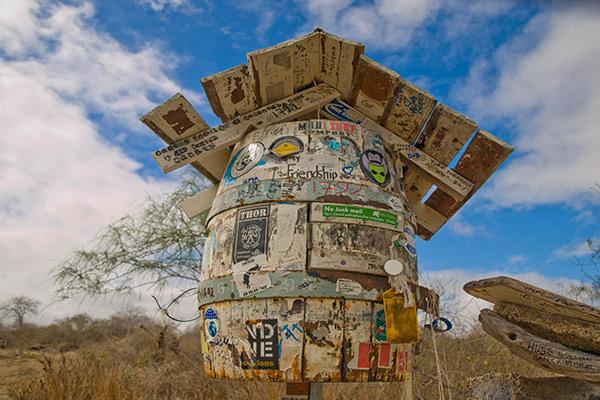
Chinese Hat Islet & Bartolome
AM: Breakfast service. Visit Santiago Island. Wet landing at Chinese Hat. Nature walk. Deepwater snorkeling. Visit Chinese Hat, a tiny island just off the southeast tip of Santiago. Its name describes the island's shape. The landing is on a beautiful crescent‐shaped white sand beach, home to Sea Lions and Sally Lightfoot Crabs. The trail on Sombrero Chino's explores its volcanic origin, one of the most evident in the islands.
The lava rock is very fragile and tends to break off when people walk over it. The sharp outcroppings caused by these breaks make it necessary to wear good walking shoes. Patches of Pahoehoe Lava cracked lava and lava tubes can be found on the island. While the path does not lead up the striking red rust sides of the Chinese Hat to the caldera, it does venture high enough on the island to offer some spectacular views of the waves crashing below. Snorkeling in the waters near Chinese Hat can create a stir; white‐tipped sharks frequent the area, as do the playful Galapagos Penguins and Sea Lions.
PM: Lunch service. Deepwater snorkeling. Visit Bartolome. Dry landing. Nature walk. This desolate island with few plants is the most visited and most photographed island in the Galapagos. The island consists of an extinct volcano and a variety of red, orange, green, and glistening black volcanic formations. The best known of the island's features is the Tuff Cone known as Pinnacle Rock. This large black partially eroded lava formation was created when magma expelled from the volcano reached the sea. When the seawaters cooled the hot lava it caused an explosion. The exploded particles eventually fasten together forming a rock composed of thin layers.
Lying beside Pinnacle Rock are twin half-moon-shaped beaches. The northern beach is a popular snorkeling site where visitors have the opportunity to swim with fish, Sea Lions and Galapagos Penguins. Much larger animals can be found near the southern beach including stingrays, spotted eagle rays, white‐tipped sharks, and black‐tipped sharks. Little vegetation grows in this barren place. Mangroves border the beach and the small shrub Tiguilia grows in the volcanic sands. The seeds and tiny white flowers of the Chamaesycae provide food for the island's finch. These plants are common to arid regions and can survive in these harsh volcanic conditions. Farewell cocktail. Dinner is served as we navigate to Santa Cruz Island.
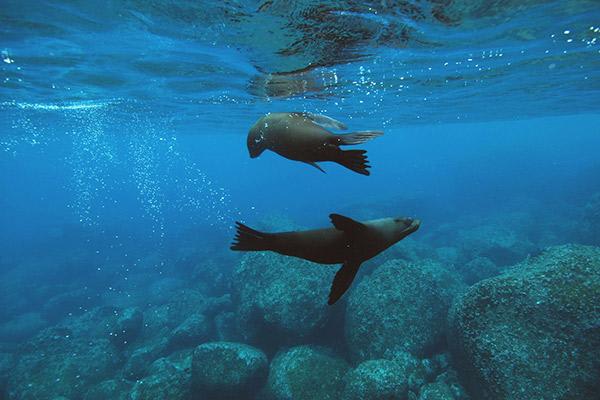
Disembarkation
AM: In the morning, you can enjoy a panga boat ride to Caleta Tortuga, also known as Black Turtle Cove. There is no landing at this sight. It is located on the north side of Santa Cruz Island and the way to reach it is by a panga boat (motorized canoe). You will be able to see its mangrove swamp where marine turtles are nesting during certain seasons of the year, as well as sharks and rays. Breakfast service. Check out and airport departure at 8:00.
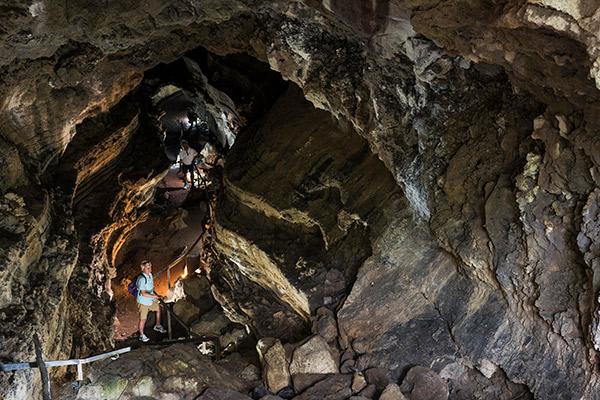
Embarkation
AM: After arriving at Baltra airport you will be greeted by a representative of the vessel then board the Nemo II, enjoy a welcome drink, and have lunch.
PM: The main visit in Puerto Ayora is to Charles Darwin Station. An excellent way to begin learning about the islands, their origin and formation. You will learn about how the Galapagos turtles are raised and meet Jorge, the famous solitary turtle. The Scientific Station has its own beach that receives many visitors on weekends
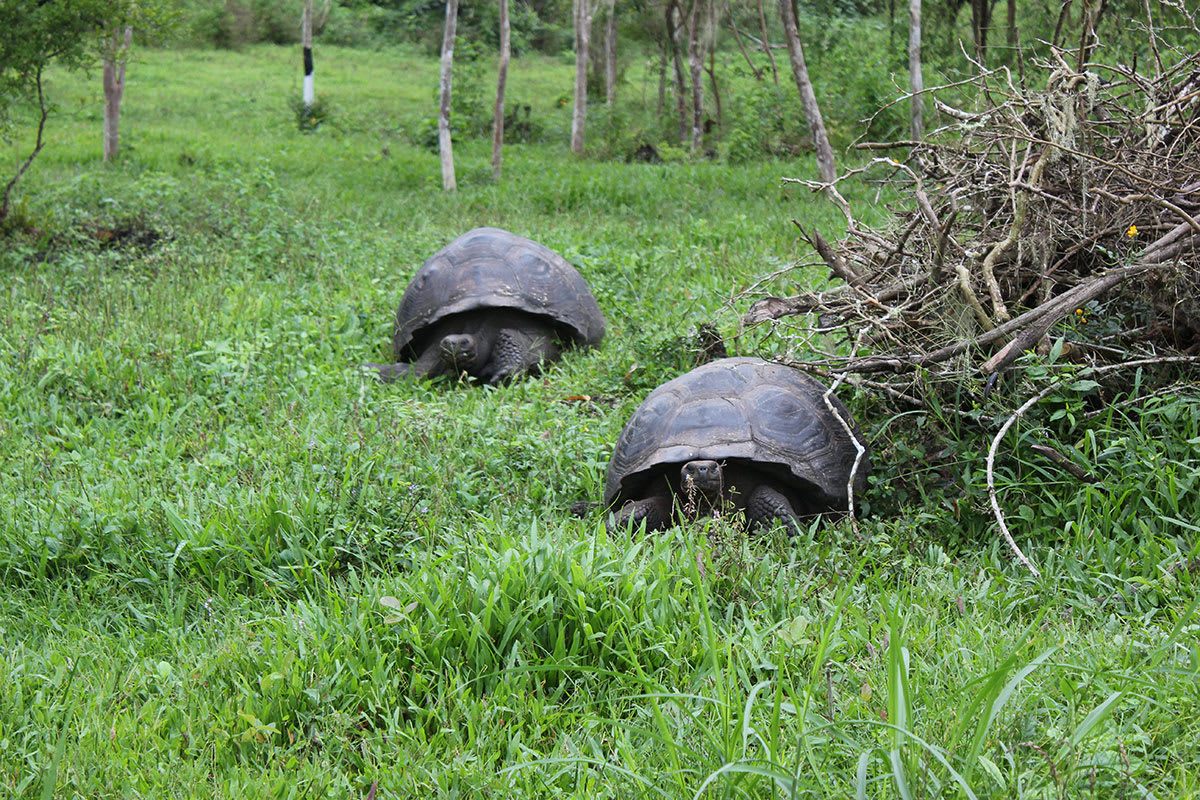
Elizabeth Bay & Urbina Bay
AM: Elizabeth Bay is one of the few places from Galapagos Archipelago in which landing is forbidden. This happens because there is not a single place to stay in, and also to preserve the natural species of plants and animals living there. However, you can swim and play some water sports as a gift. Animals will be happy to welcome you to this water paradise
PM: After lunch, the next excursion is at the foot of Alcedo Volcano, south of Tagus Cove, is Urbina Bay, one of the best and the most recent example of geological uplift in the Galapagos. Uplifts occur when the molten materials beneath the surface shifts. In 1954 the shoreline was uplifted by nearly 15 feet (4 meters). The coastline was driven 3/4 of a mile further out to sea, exposing giant coral heads and stranding marine organisms on what was now on shore.
The visit begins with a wet landing on the white sand beach. The difficulty of the route varies by season. The trail ranges from stark and easily passable during the dry season to mildly challenging requiring wading to pass during the rainy season. Visitors cross the uplifted region learning about this geological wonder. Then reach the sandy area that was once the beach. Shorter visits return to the landing point on the same path, while longer visits continue past the coral heads and new beach. Other highlights of this site include marine iguanas and some of the largest land iguanas in the islands, and Galapagos Cotton an endemic plant, historians believe the Incas brought to the islands, while naturalists theorize it floated across from Peru.
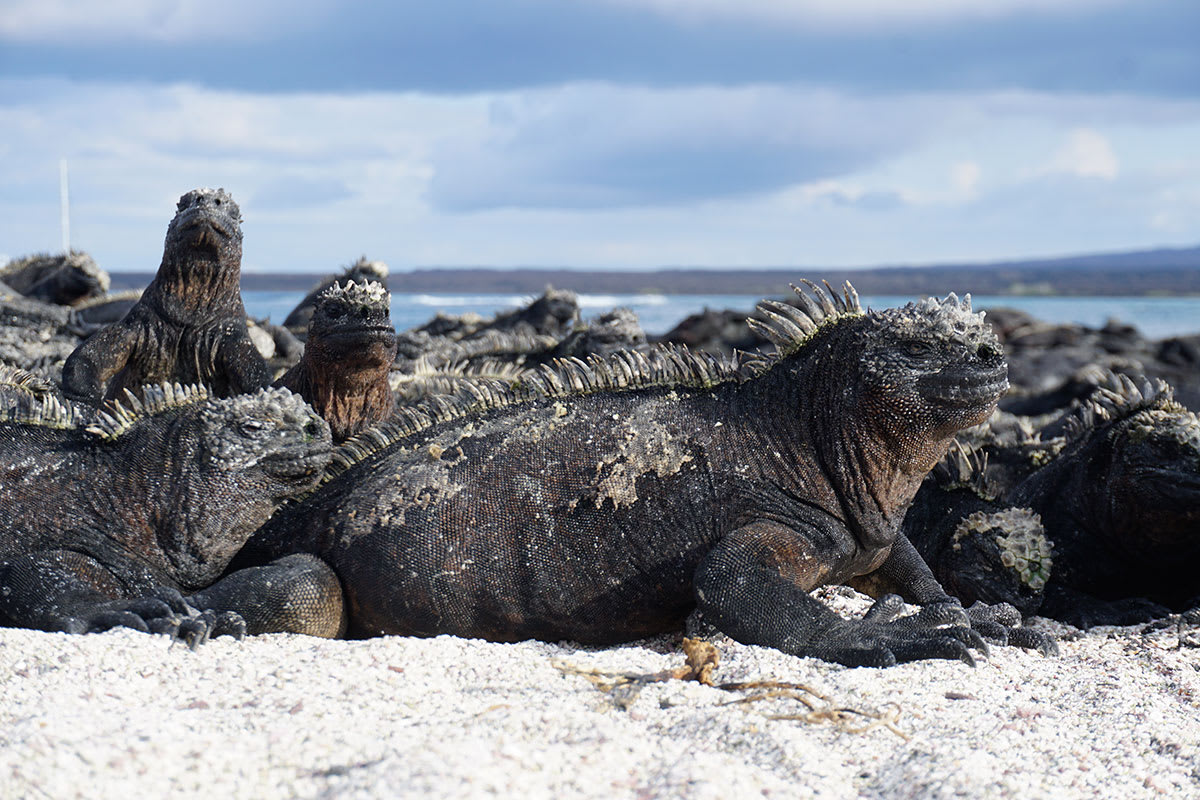
Tagus Cove & Espinoza Point
AM: Tagus cove (Isabela Island) is situated directly east of Fernandina Island on the west coast of Isabela Island. It is a beautiful, well-protected cove sheltered by the shoulders of two volcanic craters and has been used as an anchorage for over 300 years. A nature trail here ascends through the typical dry vegetation zone and offers spectacular views of Darwin Lake, a saltwater crater lake and the long narrow inlet that appears to connect with it. At the top of the trail it is possible to observe the different vegetation zones, catch a glimpse of Darwin and Wolf volcanoes, and observe Galapagos Penguins, Flightless Cormorants and Pelicans.
PM: After lunch, visit the Fernandina Island. which is the youngest and most active volcano in the Galapagos, with eruptions taking place every few years. The flat lava of Punta Espinosa offers a stark and barren landscape, but here flightless cormorants build their nests on the point, sea lions sprawl on the beach or play in the tide pools and large numbers of marine iguanas dot the sand. We also will have the opportunity to compare the Aa and Pahoehoe lava types here.
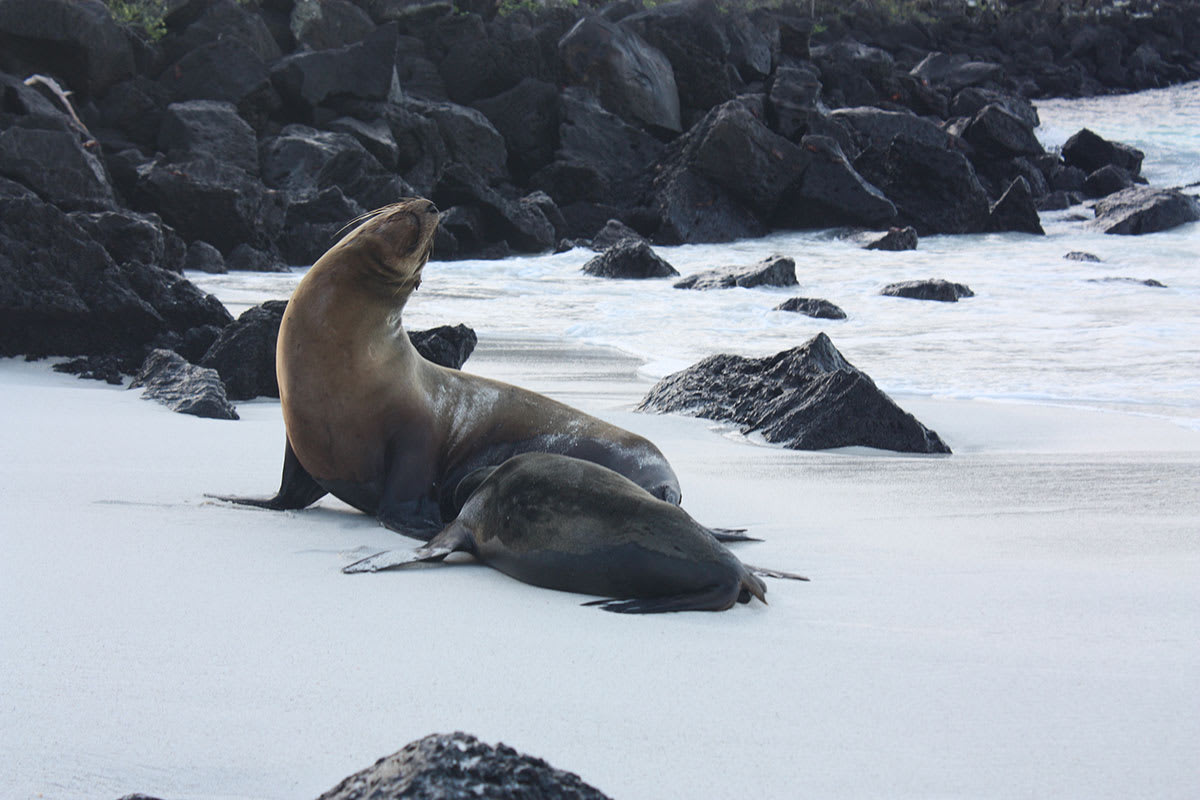
Espumilla Beach, Bucaaneer Coves, Salt Mines & Egas Port
AM: The day begins just a short distance beyond the tide pools and heads to the fur seal grotto. Fur seals and sea lions can be seen swimming in the rocky lava ringed pools. This may be the only opportunity visitors have to see and swim with fur seals. The crystal clear water, volcanic bridges, fur seals and sea lions make this a magnificent place for swimming and snorkeling.
Visitors who now come to Espumilla Beach mostly do so in search of birds rather than water. A short walk inland takes visitors through a mangrove forest normally inhabited by the common stilt. Sea turtles also visit these mangroves to nest. Beyond the mangroves is a brackish lagoon where flocks of pink flamingos and white cheeked pintails can be seen. The trail makes a loop heading over a knob into a sparely forested area then back to the beach.
Less than an hour north of Puerto Egas, Buccaneer Cove served as a safe haven for pirates, sailors and whalers during the 18th and 19th century. Anchoring in the protected bay they were able to make much needed repairs to their ships while other men went ashore to stock up on salt, tortoises, fresh water and firewood. Several years ago ceramic jars were found at the bottom of the bay, the disregarded cargo of some mariner from years ago. Inside the jars were supplies of wine and marmalade.
PM: After lunch, a visit to Puerto Egas begins with a wet landing on the dark sand beaches of James Bay. Taking a walk along the rocky coast offers visitors the opportunity to view some of the tide pools Galapagos Island's best . Sponges, snails, hermit crabs, barnacles and fish including the endemic four can be seen. The walk also presents visitors with a variety ofeyed blenny shore birds, marine iguanas, sally light foot crabs and sea lions.
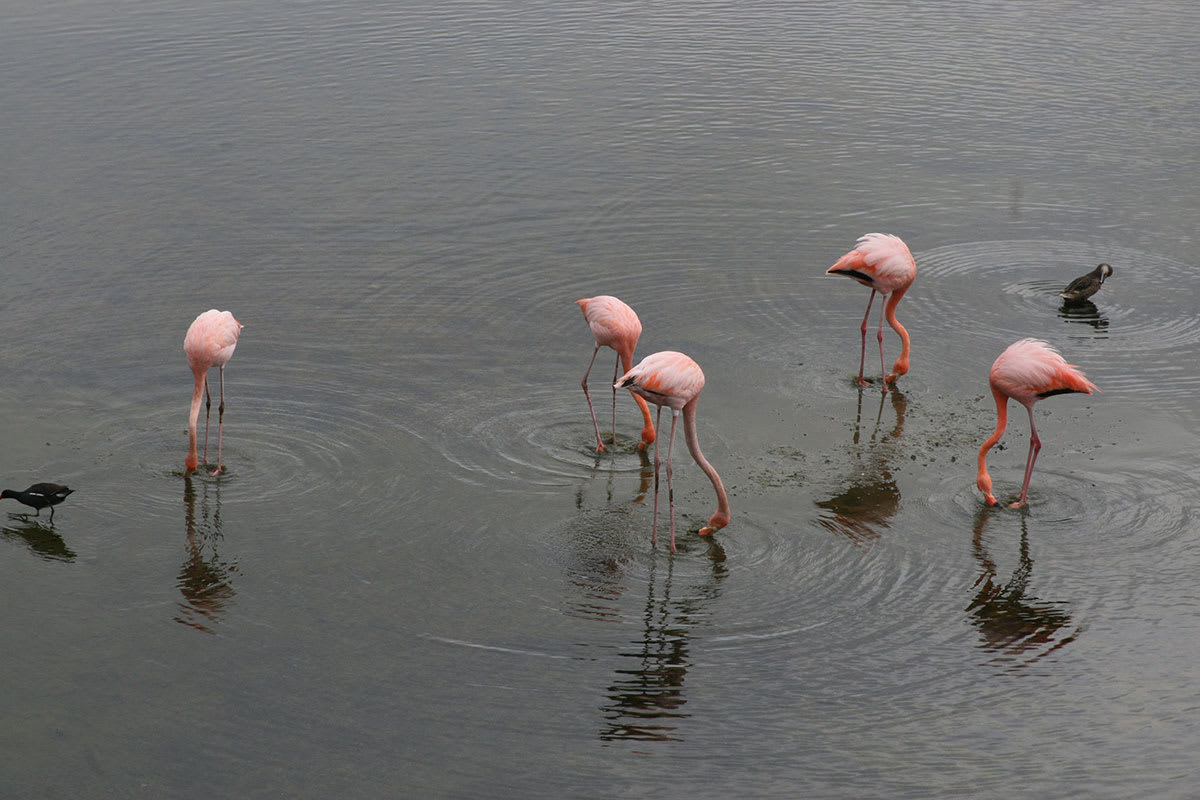
Disembarkation
AM: After your morning excursion, you will be assisted to Baltra airport for your flight to the mainland.
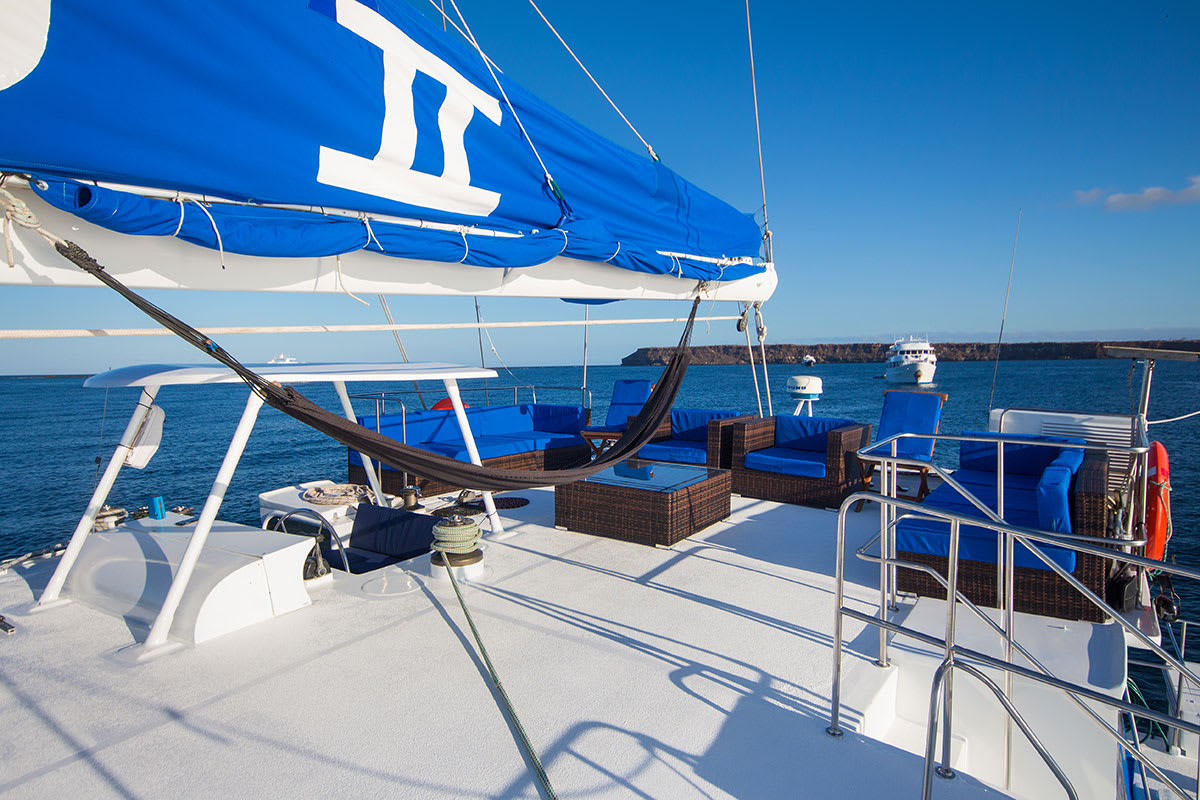
Embarkation
AM: After arriving at Baltra airport you will be greeted by a representative of the vessel then board the Nemo II, enjoy a welcome drink, and have lunch.
PM: The name is “Spanglish” for 'barges' which were wrecked offshore during World War II. A common first landing site, there is a delightful swimming beach here, with a lagoon behind, and a longer beach for a stroll and wildlife-watching. The saltwater lagoon behind often has great blue herons and small waders such as sanderlings and semi‐palmated plovers. Both beaches are nesting areas for green sea turtles, which leave tracks in the sand to the back of the beach, especially from November to February. A wet landing and open area on the beach mean one can explore at leisure.
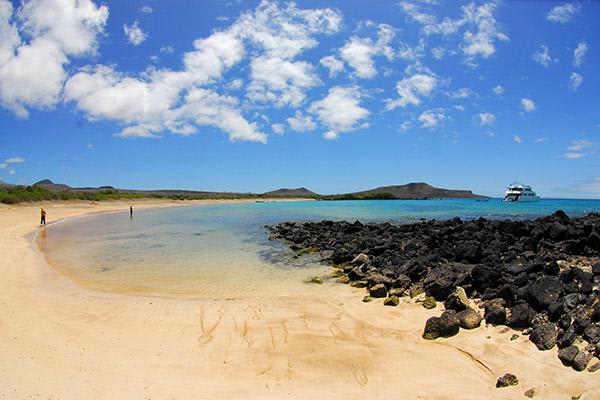
South Plaza & Santa Fe
AM: Breakfast service followed by a visit to South Plaza. The rocky trail circumnavigates the island displaying the combination of dry and coastal vegetation zone. South Plaza has one of the largest populations of Land Iguanas in the Galapagos. The iguanas seem to be everywhere once you land. These larger than average yellow‐brown land iguanas feed on the fruit and pads of the prickly pear cactus. South Plaza is also home to Marine Iguanas living along the coast and a Hybrid Iguanas whose fathers are Marine Iguanas and mothers are Land Iguanas.
PM: Lunch service. Navigation to Santa Fe. Santa Fe was formed from an uplift (rather than a volcano) giving the island a relatively flat surface rather than the typical conical shape of the other islands. Visits to Santa Fe begin with a panga boat ride across the lovely turquoise lagoon. Once ashore you are brought into contact with one of the many sea lion colonies in the Galapagos. Bulls compete for the right of beach master while cows lounge in the sun. This evening dinner will be served as we navigate to San Cristobal.
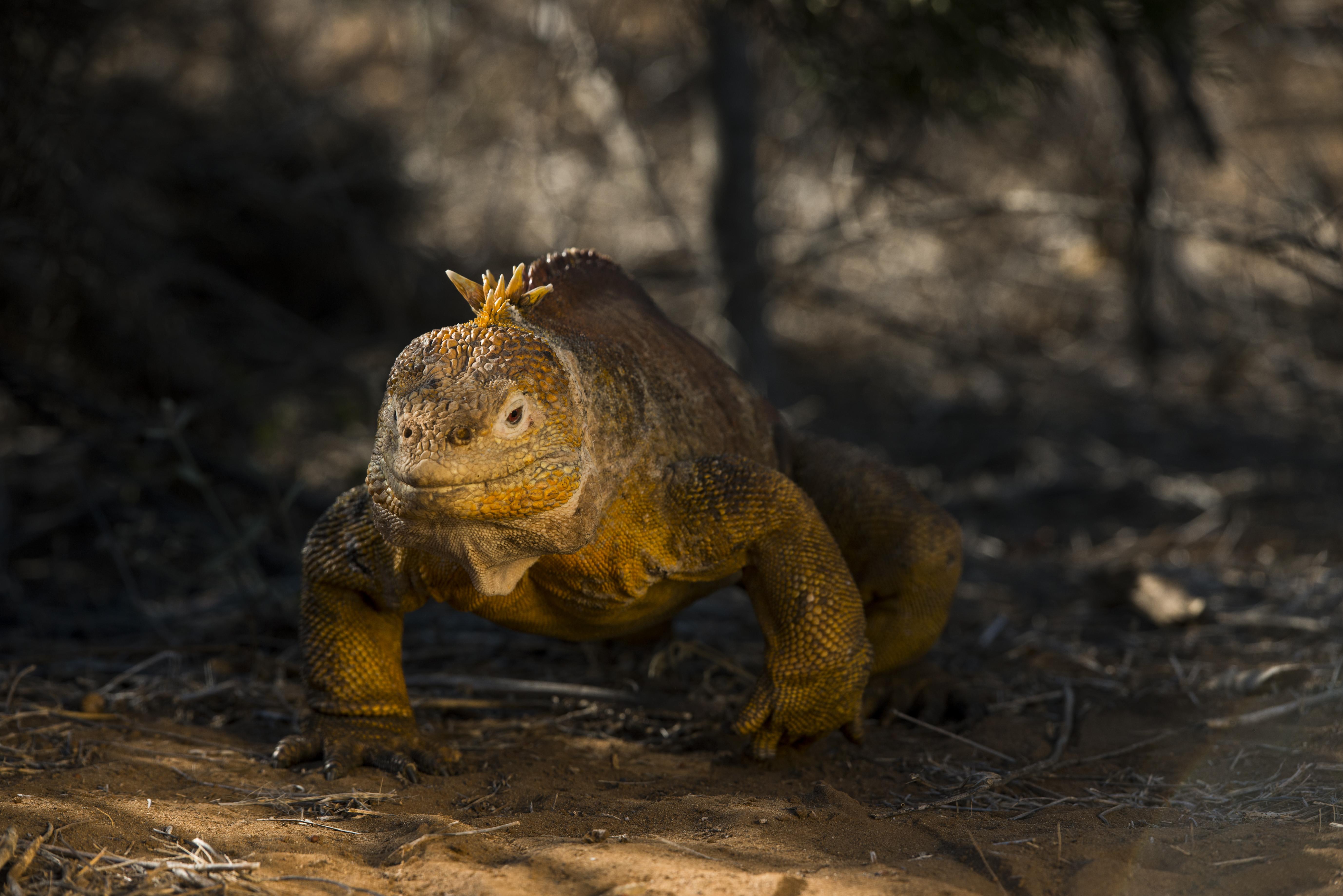
Cerro Brujo, Kicker Rock & Lobos Island
AM: One of the first sites visited by Charles Darwin, Cerro Brujo is a beautiful white sand beach where brown pelicans, blue‐footed boobies, sea lions, and marine iguanas are all found. An onshore version of nearby Kicker Rock, Cerro Brujo is a very striking, eroded tuff cone.
Also known as León Dormido, Kicker Rock is located off the coast of San Cristobal. It is the remains of a lava cone eroded by the sea, the two vertical rocks rising 500 feet from the ocean form a small channel that is navigable by small boats. This natural monument has become a favorite sight for cruises due to the many tropicbirds, frigates, and boobies that fill the surrounding air. Beneath the sea, the nearly crystal waters offer a brilliant show of colorful tropical fish and invertebrates.
PM: Lobos Island, as its name suggests is famous for its population of sea lions and fur sea lions. You will also encounter a nesting ground for the great frigate bird and a small number of blue-footed boobies. At the breeding center, they explain the series of natural processes, such as volcanic eruption and marine current locations that have lead to the amazing islands that you are now visiting.
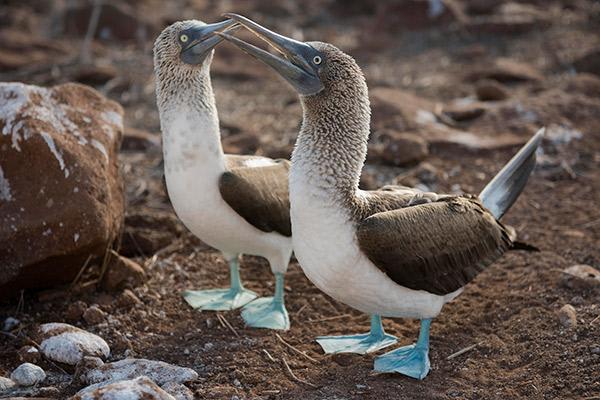
Punta Suarez, Gardner Bay, Gardner Islet & Osborn Islet
AM: Arrival to Española Island, in the morning Punta Suarez, found on the western tip of Española, Punta Suarez offers great wildlife such as Sea Lions, sea birds, and the largest Marine Iguanas of Galapagos. This is one of the best sites in the Galapagos. The amount of wildlife is overwhelming. Along the beach, there are many Sea Lions and large, colorful Lava Lizards, and Marine Iguanas. As you follow the trail to the cliff's edge masked and blue-footed boobies can be found nesting among the rock formations. As you follow the trail to the cliff's edge Masked Boobies can be found nesting among the rock formations.
PM: Visit Gardner Bay, this bay is a 45‐minute boat ride from Punta Suarez. It has a white sand beach and there is a small colony of sea lions. The possibilities for swimming or scuba diving are excellent here. Visitors find migrant, resident, and endemic wildlife including brightly colored Marine Iguanas, Española Lava Lizards, Hood Mockingbirds, Swallow-Tailed Gulls, Blue Footed, and Masked Boobies, Galapagos Hawks, a selection of Finch, and the Waved Albatross. Snorkel and go on a panga ride at Gardner Islet, and Osborn Islet snorkel once ore.

Disembarkation
AM: In the morning, explore the highlands of Santa Cruz which have incredible zones of vegetation. Visit the private estate “Las Primicias”. This reserve offers you one of the best possibilities to see the huge turtles of Santa Cruz Island in their natural habitat. You can observe them from very close. After your morning excursion, you will be assisted to Baltra airport for your flight to the mainland.
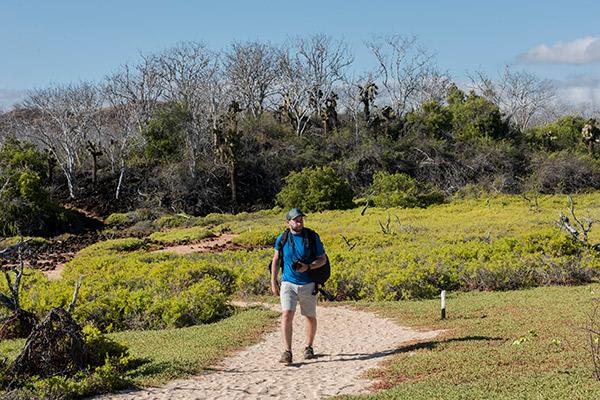
Embarkation
AM: After arriving at Baltra airport you will be greeted by a representative of the vessel then board the Nemo II, enjoy a welcome drink, and have lunch.
PM: Arrival at the airport in Baltra, reception by the cruising guide, and transfer to the yacht. Navigation to Seymour north of Baltra. The visitor trail on North Seymour is approximately (2 km) in length crossing the inland of the island and exploring the rocky coast. Along the way, the trail passes colonies of Blue‐Footed Boobies and Magnificent Frigatebirds. The Magnificent Frigatebird, a large black bird with a long wingspan, and a hooked beak is extremely fast and has excellent vision. Frigatebirds are known for the large red pouch on their necks. Boobies and Frigates share an interesting relationship. Sharing the same nesting area on North Seymour Blue‐ Footed Boobies nest on the ground making their nests from the twigs of the Palo Santos Trees, while the Magnificent Frigate bird nests just above them in the saltbushes.
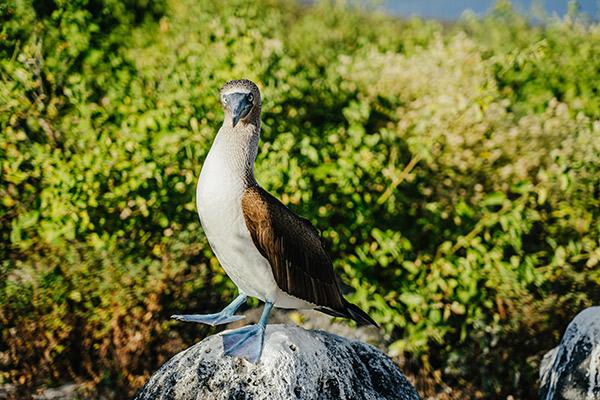
Santa Cruz Highlands & Charles Darwin Research Center
AM: The highlands of Santa Cruz have incredible zones of vegetation. There you will visit the private “Las Primicias”. This reserve offers you one of the best possibilities to see the huge turtles of Santa Cruz Island in their natural habitat. You can observe them from very close.
PM: In the afternoon visit Charles Darwin Research Center. An excellent way to begin learning about the islands and their origin and formation is to visit the Station. You can also see how the Galapagos turtles are raised and meet Jorge, the famous solitary turtle.
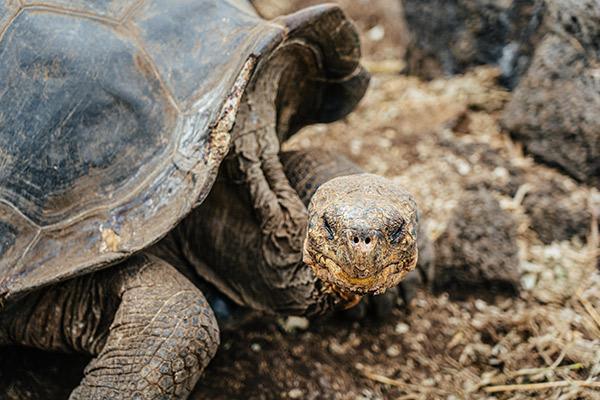
Moreno Point & Urbina Bay
AM: A colorful part of any tour located on the western shore of Isabela, Punta Moreno is often the first or last stopping point on the island (depending on the direction the boat is heading). Punta Moreno is a place where the forces of the Galapagos have joined to create a work of art. The tour starts with a panga ride along the beautiful rocky shores where Galapagos penguins and shorebirds are frequently seen. After a dry landing, the path traverses through jagged black lava rock.
As the swirling black lava flow gave way to form craters, crystal tide pools formed‐some surrounded by mangroves. This is a magnet for small blue lagoons, pink flamingos, blue herons, and Bahama pintail ducks. Brown pelican can be seen nesting in the green leaves of the mangroves. You can walk to the edge of the lava to look straight down on these pools including the occasional green sea turtle, white‐tipped shark, and pufferfish. This idyllic setting has suffered from the presence of introduced species. Feral dogs in the area are known to attack sea Lions and marine iguanas.
PM: Lying at the foot of Alcedo Volcano, south of Tagus Cove, is Urvina Bay (Urbina Bay) one of the best and the most recent example of geological uplift in the Galapagos. Uplift occurs when the molten materials beneath the surface shifts. In 1954 the shoreline was uplifted nearly 15 feet (4 meters). The coastline was driven 3/4 of a mile further out to sea, exposing giant coral heads and stranding marine organisms on what was now onshore. A Disney film crew visited the site shortly afterward and discovered skeletons of sharks, sea turtles, and lobsters unable to find the ocean from the rapidly rising land. Schools of fish were found stranded in newly formed tide pools. Boulder sized coral heads can be seen near the area that once was the beach. The uplifting of Urbina Bay was followed by an eruption of Alcedo a few weeks later. Seasonally Urvina Bay provides a nesting area for many of the Galapagos creatures. Female tortoises journey down from Alcedo to lay their eggs in the sand. Galapagos penguins, flightless cormorants, and brown pelicans nest in the area as well.
The visit begins with a wet landing on the white sand beach. The difficulty of the route varies by season. The trail ranges from stark and easily passable during the dry season to mildly challenging requiring wading to pass during the rainy season. Visitors cross the uplifted region learning about this geological wonder. Then reach the sandy area that was once the beach. Shorter visits return to the landing point on the same path, while longer visits continue past the coral heads and new beach. Other highlights of this site include marine iguanas and some of the largest land iguanas in the islands, and Galapagos Cotton an endemic plant, historians believe the Incas brought to the islands, while naturalist theorizes it floated across from Peru.

Tagus Cove & Espinosa Point
AM: Tagus Cove is situated directly east of Fernandina Island on the west coast of Isabela Island. It is a beautiful, well‐protected cove sheltered by the shoulders of two volcanic craters and has been used as an anchorage for over 300 years. A nature trail here ascends through the typical dry vegetation zone and offers spectacular views of Darwin Lake, a saltwater crater lake, and the long narrow inlet that appears to connect with it. At the top of the trail, it is possible to observe the different vegetation zones, catch a glimpse of Darwin and Wolf volcanoes, and observe Galapagos penguins, Flightless cormorants, and pelicans.
PM: Fernandina Island is the youngest and most active volcano in the Galapagos, with eruptions taking place every few years. The flat lava of Punta Espinosa offers a stark and barren landscape, but here flightless cormorants build their nests on the point, sea lions sprawl on the beach, or play in the tide pools and large numbers of marine iguanas dot the sand. We also will have the opportunity to compare the AA and pahoehoe lava types here.
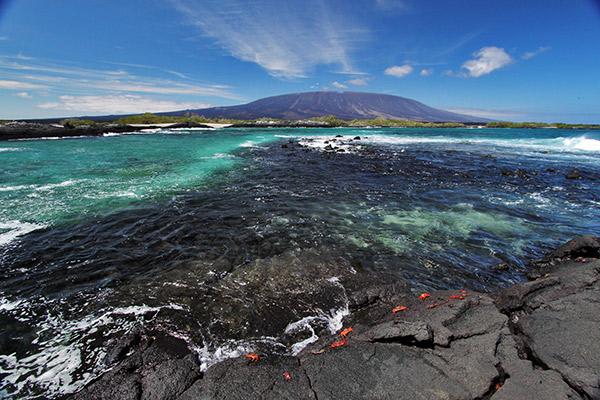
Puerto Egas, Espumilla Beach & Buccaneer's Cove
AM: A visit to Puerto Egas begins with a wet landing on the dark sand beaches of James Bay. The visit begins with a walk along the rocky coast allowing visitors to view some of the Galapagos Island's best tide pools. Sponges, snails, hermit crabs, barnacles, and fish including the endemic four‐eyed blenny can be seen. The walk also presents visitors with a variety of shorebirds, marine iguanas, sally lightfoot crabs, and sea lions. There are two interesting excursions normally visited from Puerto Egas. The first is a short walk from the landing site that brings visitors to the site of one of the Galapagos' first entrepreneur endeavors. For decades salt was extracted from a local salt crater. The industry was abandoned in the 1950s leaving behind a variety of rusted old machines and parts of buildings. The trail follows the path once used by wagon trains to the crater cone.
The steep trail is easy, but can often seem one of the hottest hikes in the islands. Feral goats prune the arid vegetation, which lines the trail. The goats feed on any leaf within reach leaving little left for the endemic island creatures. Bird lovers will be delighted with the opportunity to catch a glimpse of one of Darwin's finches, the endemic Galapagos hawk, or the colorful vermillion flycatcher. Finally reaching the crater rim presents an incredible vista. Looking into the crater you can see this extinct volcano whose floor has sunken below sea level. Saltwater seeps into the crater creating a small salt lake. The sun evaporates the water, leaving the salt that many have tried to mine without success.
Looking away from the crater are the older orange lava fields supporting vegetation including the palo santo trees and the younger desolate black lava fields. The second excursion begins just a short distance beyond the tide pools is the fur seal grotto. Fur seals and sea lions can be seen swimming in the rocky lava ringed pools. This may be the only opportunity visitors have to see and swim with fur seals. Fur seals were once hunted to near extinction for their coats. The Galapagos Fur Seal is the smallest of the fur seals found in the southern hemisphere, now compare in numbers with the sea lions. During the day they hide from the hot equatorial sun on shelves or caves of the rocky lava cliffs. At night they feed on squid and fish avoiding the sharks, which are their natural predator. The crystal clear water, volcanic bridges, fur seals, and sea lions make this a magnificent place for swimming and snorkeling.
PM: Visitors who now come to Espumilla Beach come in search of birds rather than water. A short walk inland takes visitors through a mangrove forest normally inhabited by the common stilt. Sea turtles also visit these mangroves to nest. Beyond the mangroves is a brackish lagoon where flocks of pink flamingos and white-cheeked pintails can be seen. The trail makes a loop heading over a knob into a sparely forested area then back to the beach. Along the way, those with a watchful eye may spot a variety of Darwin finches or a vermilion flycatcher. Once back at the beach visitors may have the chance to swim or snorkel time permitting.
Less than an hour north of Puerto Egas, Buccaneers Cove served as a haven for pirates, sailors, and whalers during the 18th and 19th centuries. Anchoring in the protected bay they were able to make much-needed repairs to their ships while other men went ashore to stock up on salt, tortoises, freshwater, and firewood. Several years ago ceramic jars were found at the bottom of the bay, the disregarded cargo of some mariner from years gone by. Inside the jars were supplies of wine and marmalade. Few boats stop at Buccaneers Cove today. Though many cruises by at a slow speed allowing visitors to view the cliffs made of tuff formations and the dark reddish‐purple sand beach. This dramatic landscape is made all the more impressive by the hundreds of seabirds perched atop the cliffs. Two of the more recognizable rock formations are known as the "monk" and "elephant rock". A large population of feral goats now frequents Buccaneers Cove and this portion of Santiago. The National Park Service has fenced off part of the area to protect the native vegetation from the destructive eating habits of this introduced species. A wet landing on the large coffee‐colored sand beach is just north of the prized fresh water supply that once attracted pirates and whalers.
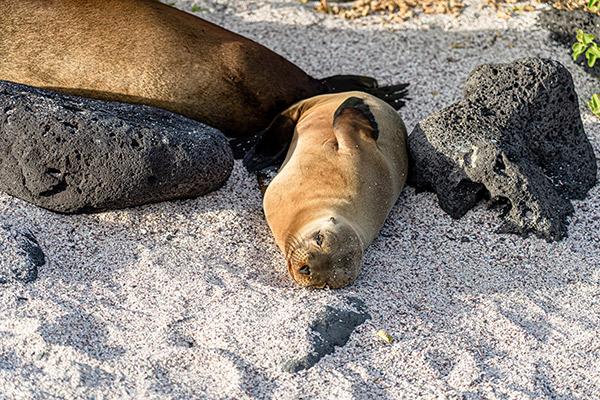
Rabida Island & Sullivan Bay
AM: One of the special features of Rabida Island is its remarkable red color, which is a result of the high percentage of oxidized iron in the composition of lava. Here we will witness the nine varieties of finches also the large‐billed flycatchers and brown pelicans. Here a small salt‐water lagoon where Greater Flamingos can be seen and a beautiful colony of sea lions.
PM: The main attraction of this bay is the broad, pahoehoe, or rope lava flow. It is one of the most incredible places to compare the lava flows and their characteristics.

El Barranco & Darwin Bay
AM: Also known as Prince Phillips Steps, this is a demanding walk up a cliff, where tropicbirds, red‐footed boobies, and other nesting seabirds can be found. We follow the trail through a palo santo forest to a storm petrel colony passing boobies and great frigate birds along the way.
PM: Darwin Bay is the caldera of a collapsed volcano, we land on a small coral beach, where we take an easy walk. For those that want this will lead to a more demanding walk over lava rock. This will allow for stunning views from the cliffs and allow apple time and opportunity to photograph the amazing birdlife such as swallow‐tailed gulls, red-footed booby, Nazca booby, large ground finch, large cactus finch, sharp‐billed ground finch, small marine iguanas, and great frigate bird. Dinner at night and navigation to Daphne
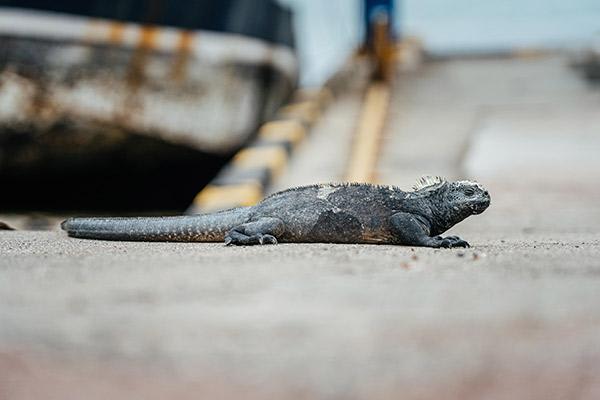
Disembarkation
AM: Among the central islands of the Galapagos Archipelago, Islas Daphne sits north of Isla Santa Cruz and west of Isla Baltra. Two islands known as Daphne Major and Daphne Minor, Islas Daphne is one of the more accessible Galapagos Islands.
After the morning excursion, you will be assisted to Baltra airport for your flight to the mainland.
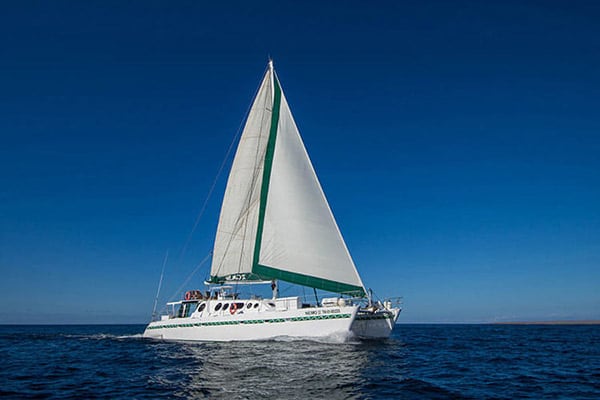
Embarkation
AM: After arriving at Baltra airport you will be greeted by a representative of the vessel then board the Nemo II, enjoy a welcome drink, and have lunch.
PM: The name is “Spanglish” for 'barges' which were wrecked offshore during World War II. A common first landing site, there is a delightful swimming beach here, with a lagoon behind, and a longer beach for a stroll and wildlife-watching. The saltwater lagoon behind often has great blue herons and small waders such as sanderlings and semi‐palmated plovers. Both beaches are nesting areas for green sea turtles, which leave tracks in the sand to the back of the beach, especially from November to February. A wet landing and open area on the beach mean one can explore at leisure.
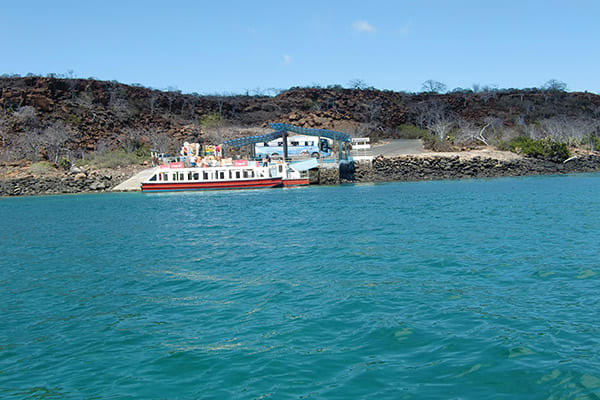
South Plaza & Santa Fe
AM: Breakfast service followed by a visit to South Plaza. The rocky trail circumnavigates the island displaying the combination of dry and coastal vegetation zone. South Plaza has one of the largest populations of Land Iguanas in the Galapagos. The iguanas seem to be everywhere once you land. These larger than average yellow‐brown land iguanas feed on the fruit and pads of the prickly pear cactus. South Plaza is also home to Marine Iguanas living along the coast and a Hybrid Iguanas whose fathers are Marine Iguanas and mothers are Land Iguanas.
PM: Lunch service. Navigation to Santa Fe. Santa Fe was formed from an uplift (rather than a volcano) giving the island a relatively flat surface rather than the typical conical shape of the other islands. Visits to Santa Fe begin with a panga boat ride across the lovely turquoise lagoon. Once ashore you are brought into contact with one of the many sea lion colonies in the Galapagos. Bulls compete for the right of beach master while cows lounge in the sun. This evening dinner will be served as we navigate to San Cristobal.
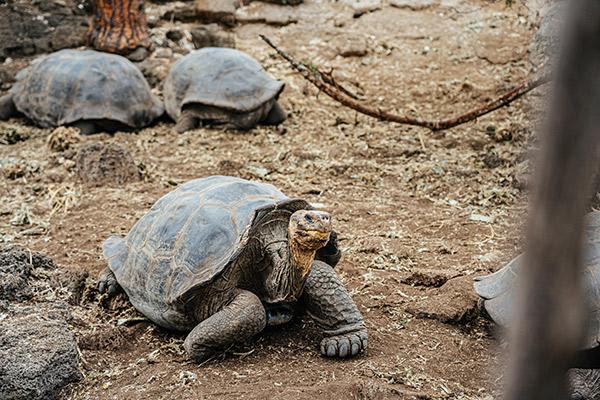
Cerro Brujo, Kicker Rock & Lobos Island
AM: One of the first sites visited by Charles Darwin, Cerro Brujo is a beautiful white sand beach where brown pelicans, blue‐footed boobies, sea lions, and marine iguanas are all found. An onshore version of nearby Kicker Rock, Cerro Brujo is a very striking, eroded tuff cone.
Also known as León Dormido, Kicker Rock is located off the coast of San Cristobal. It is the remains of a lava cone eroded by the sea, the two vertical rocks rising 500 feet from the ocean form a small channel that is navigable by small boats. This natural monument has become a favorite sight for cruises due to the many tropicbirds, frigates, and boobies that fill the surrounding air. Beneath the sea, the nearly crystal waters offer a brilliant show of colorful tropical fish and invertebrates.
PM: Lobos Island, as its name suggests is famous for its population of sea lions and fur sea lions. You will also encounter a nesting ground for the great frigate bird and a small number of blue-footed boobies. At the breeding center, they explain the series of natural processes, such as volcanic eruption and marine current locations that have lead to the amazing islands that you are now visiting.

Punta Suarez, Gardner Bay, Gardner Islet & Osborn Islet
AM: Arrival to Española Island, in the morning Punta Suarez, found on the western tip of Española, Punta Suarez offers great wildlife such as Sea Lions, sea birds, and the largest Marine Iguanas of Galapagos. This is one of the best sites in the Galapagos. The amount of wildlife is overwhelming. Along the beach, there are many Sea Lions and large, colorful Lava Lizards, and Marine Iguanas. As you follow the trail to the cliff's edge masked and blue-footed boobies can be found nesting among the rock formations. As you follow the trail to the cliff's edge Masked Boobies can be found nesting among the rock formations.
PM: Visit Gardner Bay, this bay is a 45‐minute boat ride from Punta Suarez. It has a white sand beach and there is a small colony of sea lions. The possibilities for swimming or scuba diving are excellent here. Visitors find migrant, resident, and endemic wildlife including brightly colored Marine Iguanas, Española Lava Lizards, Hood Mockingbirds, Swallow-Tailed Gulls, Blue Footed, and Masked Boobies, Galapagos Hawks, a selection of Finch, and the Waved Albatross. Snorkel and go on a panga ride at Gardner Islet, and Osborn Islet snorkel once ore.
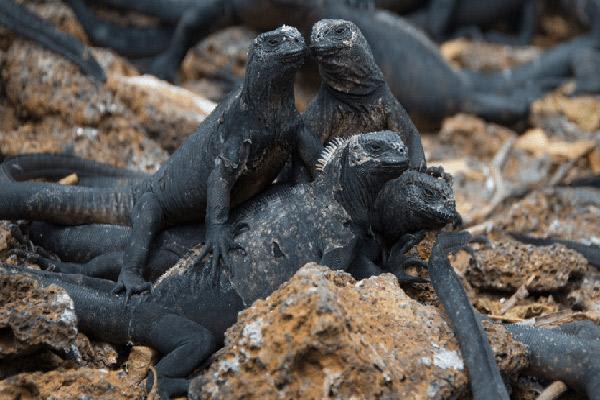
Santa Cruz Highlands & Charles Darwin Station
AM: Breakfast service. Today we visit the highlands of Santa Cruz, which have incredible zones of vegetation. Visit the private estate “Las Primicias”. This reserve offers you one of the best possibilities to see the huge turtles of Santa Cruz Island in their natural habitat. You can observe them from very close.
PM: Lunch service. Visit Charles Darwin Scientific Station and Breeding Center. The main visit to Puerto Ayora is to Charles Darwin Station. An excellent way to begin learning about the islands, their origin, and their formation. You will learn about how the Galapagos turtles are raised and meet George, the famous solitary turtle. The Scientific Station has its own beach that receives many visitors on weekends. This evening dinner is served as we navigate to Floreana Island.
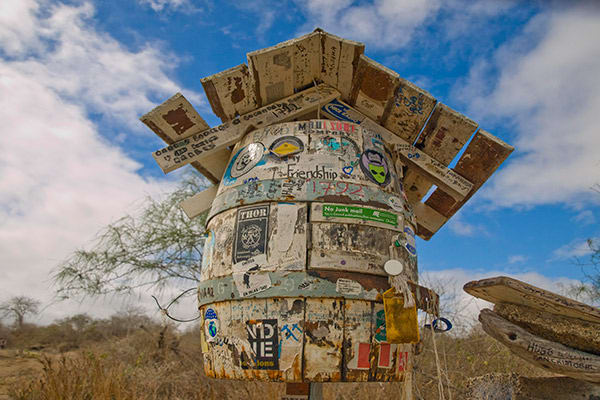
Cormorant Point, Champion Islet & Post Office Bay
AM: Breakfast service. The visit to Cormorant Point offers two contrasting beaches. Arriving on shore you will encounter a green sand beach (the green sand is caused by the olivine crystals derived silicates or magnesium and iron). From here you will follow the trail leading to a lagoon where Pink Flamingoes and other shorebirds can be seen. If you look closely at the mud of this lagoon, there appear to be 'cracks' in the mud. These cracks are not caused by dryness but are actual flamingo footpaths. This is also a good spot for seeing Large‐Billed Flycatchers, Small‐Ground Finches, Medium‐Ground Finches, or Cactus Finches.
The walk continues to another beach on the other side made of fine white sand particles known as "Flour Beach". In the waters, Ghost Crabs and Rays can be seen swimming. Time and weather permitting you may even go for a swim or a snorkel. Other activities include a panga ride to Champion Point and kayaking at Baroness Viewpoint.
PM: Lunch service. Panga boat ride to Post Office Bay. Wet landing. Nature walk. Snorkeling from the beach. Arriving at Post Office Bay you will land on a brown sand beach, passing the sea lions lying in the sun. At the post barrel, the guide will pull a handful of letters for the group. Continuing the tradition, the letters are brought home with the traveler and then mailed to the addressee. Visitors also have the opportunity to send letters of their own. Dinner will be served as we navigate to Santiago Island.
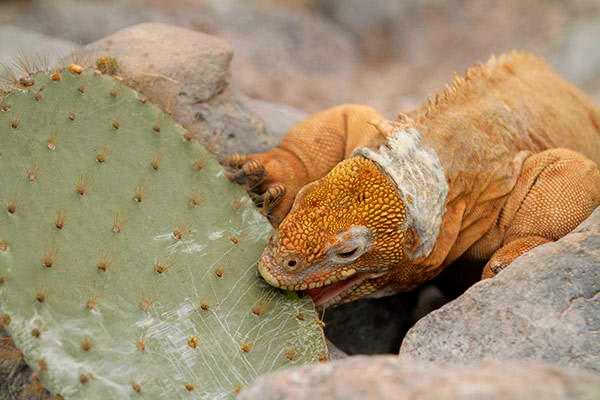
Chinese Hat & Bartolomew Island
AM: Visit Sombrero Chino, a tiny island just off the southeast tip of Santiago. Its name (Chinese Hat) describes the island's shape. Those visitors who travel to the island will find its special landscape worth the visit. Though centrally located it is one of the least visited sites in the area. National Park Service restrictions have limited the number of visitors to Sombrero Chino. Multi‐day cruises with 12 passengers or less are the only ones permitted at this site. The landing is on a beautiful crescent‐shaped white sand beach, home to Sea Lions and Sally Lightfoot Crabs. The trail on Sombrero Chino explores its volcanic origin, one of the most evident in the islands.
The lava rock is very fragile and tends to break off when people walk over it. The sharp outcroppings caused by these breaks make it necessary to bring good shoes. Patches of Pahoehoe Lava cracked lava and lava tubes can be found on the island. While the path does not lead up the striking red rust sides of the Sombrero to the caldera, it does venture high enough on the island to offer some spectacular views of the waves crashing below. Snorkeling in the waters near Sombrero Chino can create a stir; white‐tipped sharks frequent the area, as do the playful Galapagos Penguins and Sea Lions.
PM: Desolate island with few plants is the most visited and most photographed island in the Galapagos. The island consists of an extinct volcano and a variety of red, orange, green, and glistening black volcanic formations. The best known of the island's features is the Tuff Cone known as Pinnacle Rock. This large black partially eroded lava formation was created when magma was expelled from the volcano reached the sea. When the seawaters cooled the hot lava it caused an explosion. The exploded particles eventually fasten together forming a rock composed of thin layers. Bartolome's Pinnacle Rock has become one of the best-recognized and most photographed sights in the islands. A prominent sight it was used as a target for US airmen during WWII. Lying beside the Pinnacle Rock are twin half moon shaped beaches.
The northern beach is a popular snorkeling site where visitors have the opportunity to swim with fish, Sea Lions and Galapagos Penguins. Much larger animals can be found near the southern beach including stingrays, spotted eagle rays, white‐tipped sharks, and black‐tipped sharks. Little vegetation grows in this barren place. Mangroves border the beach and the small shrub Tiguilia grows in the volcanic sands. The seeds and tiny white flowers of the Chamaesycae provide food for the island's finch. These plants are common to arid regions and can survive in these harsh volcanic conditions.
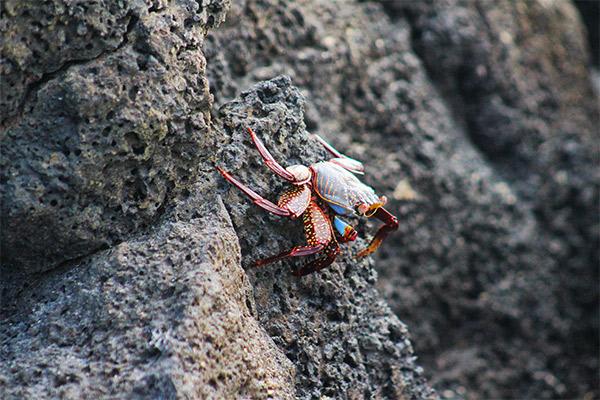
Disembarkation
AM: In the morning, panga ride in Caleta Tortuga, also known as Black Turtle Cove, It is on the north side of Santa Cruz. You have to go by panga (motorized canoe) to reach it and see its mangrove swamp where there are nesting marine turtles during certain seasons of the year, and also sharks and rays.
After your morning excursion, you will be assisted to Baltra airport for your flight to the mainland.
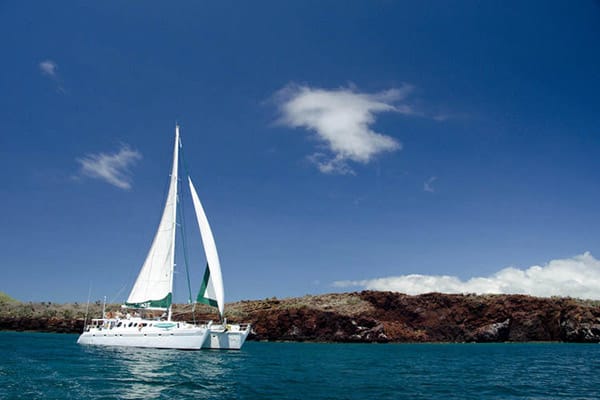
Accommodations
Social Areas
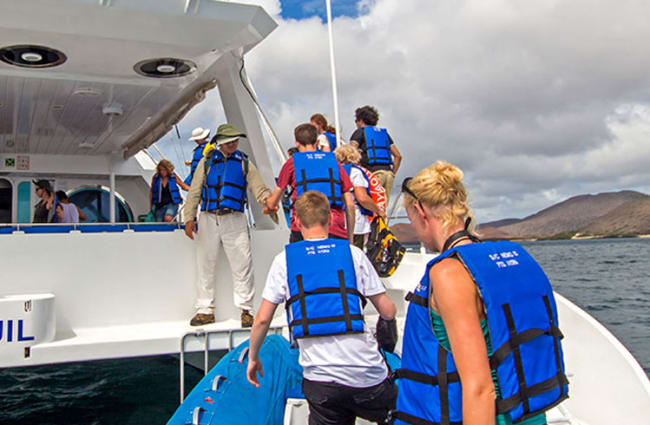
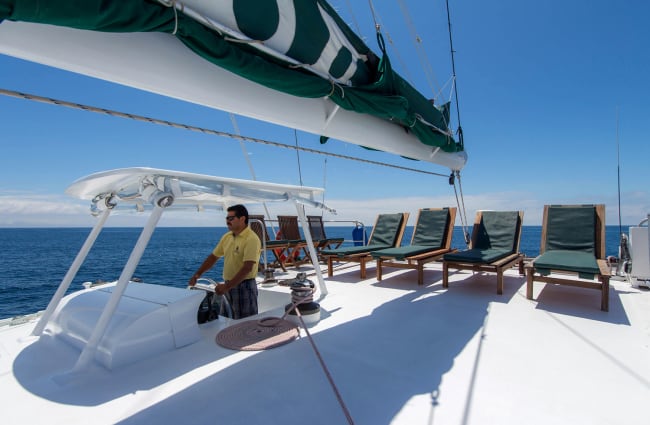
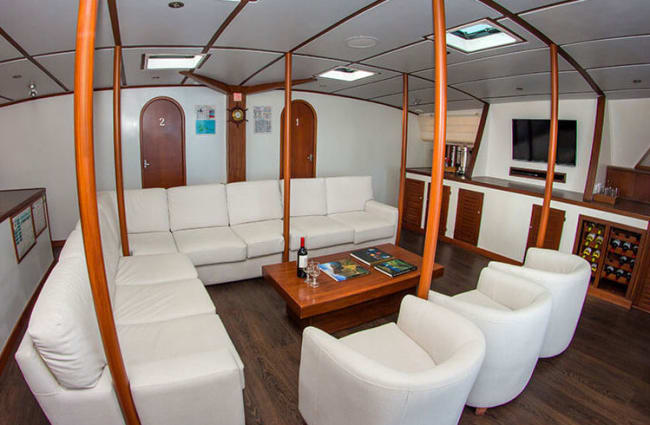
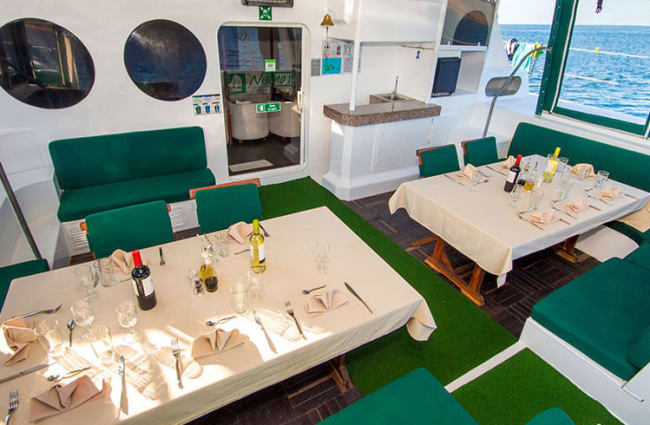
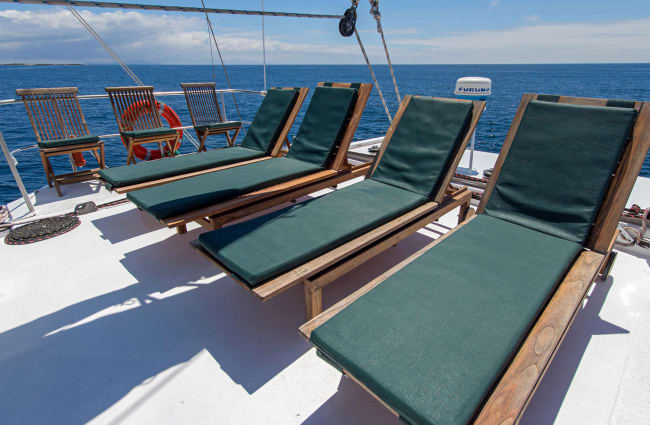
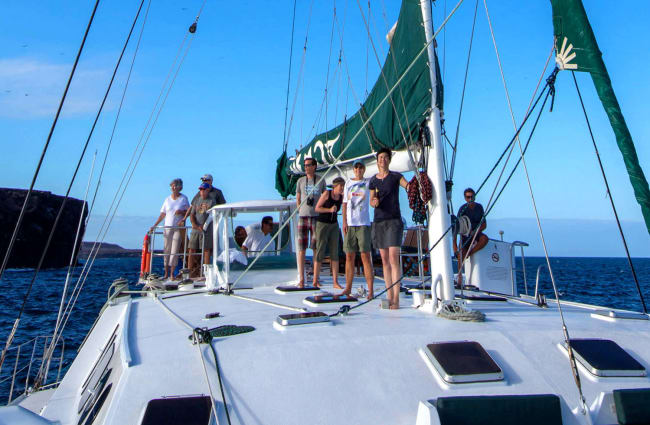
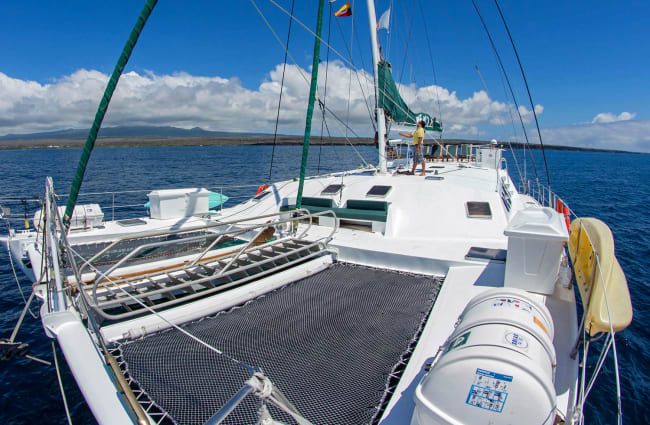
Suites & Cabins

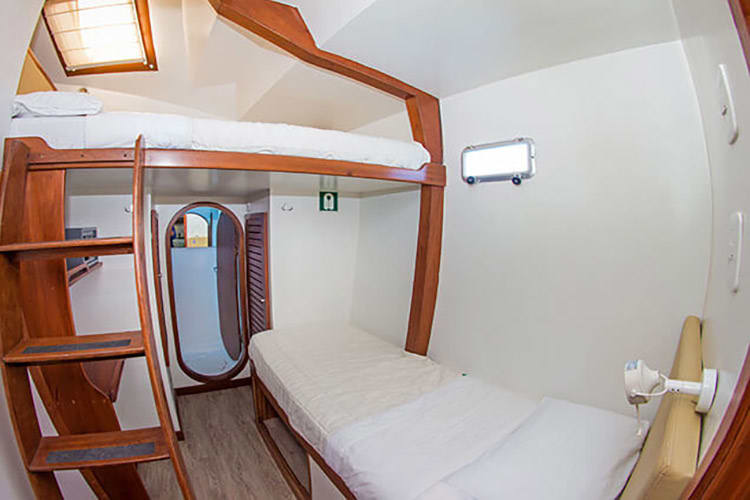
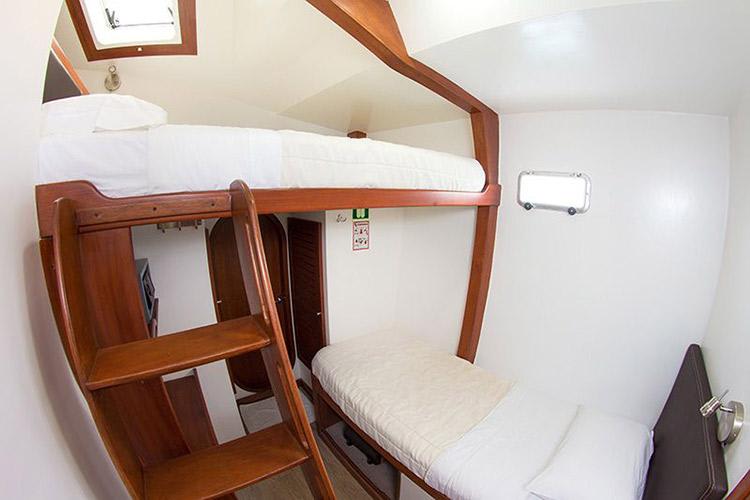
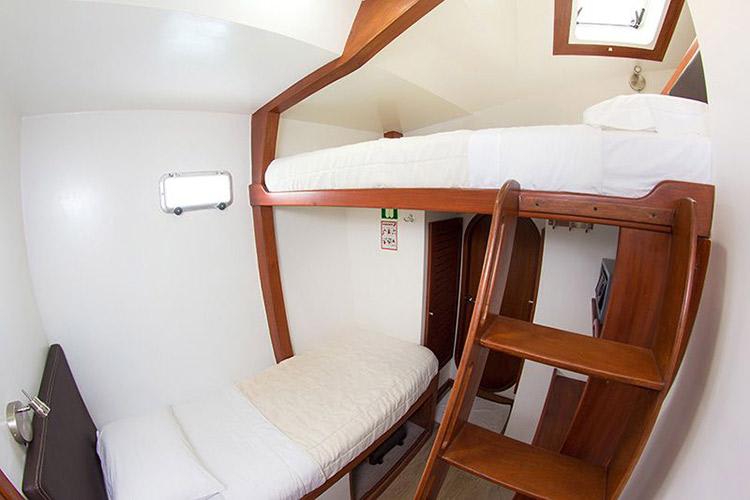
Standard Cabin
These sizeable cabins receive adequate natural light from the skylights and the small high-set rectangular windows. These air-conditioned rooms also feature several electrical outlets for your gadgets, a cupboard, a lamp, plus stylish private bathrooms with hot water, a wet-room style shower, and a toilet. Cabins #6 & #7.
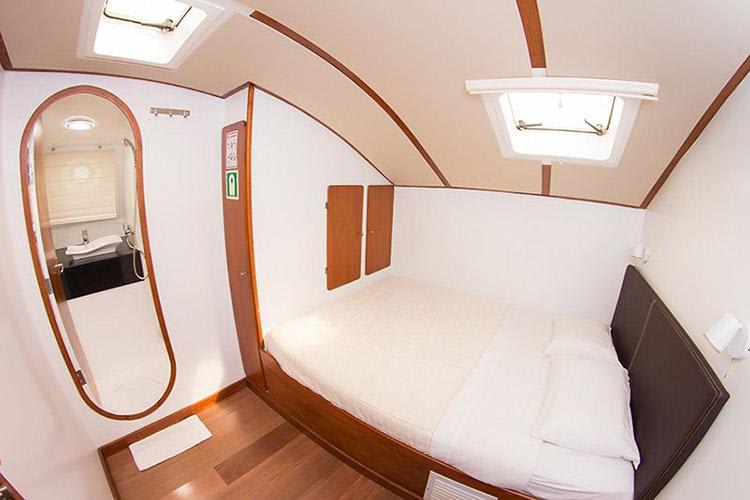
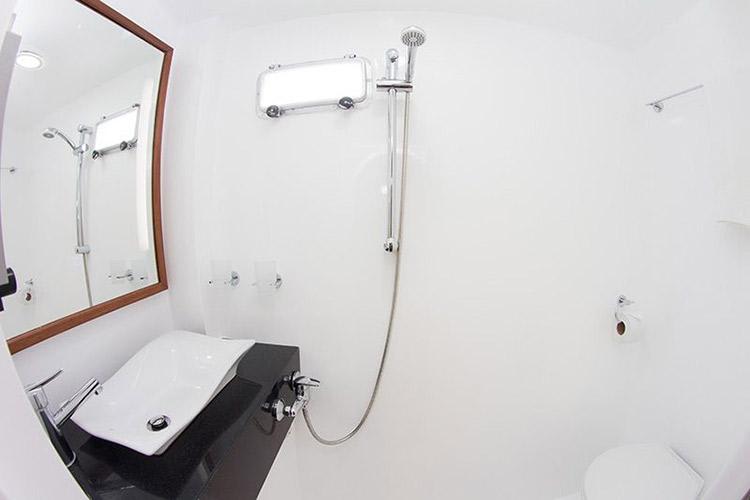
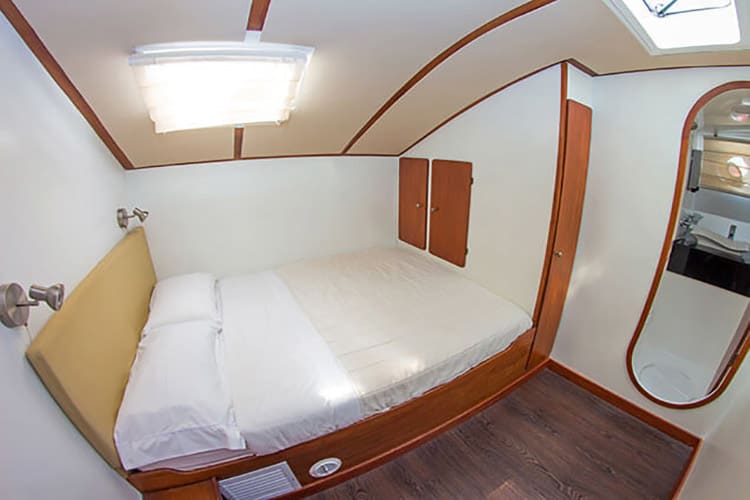
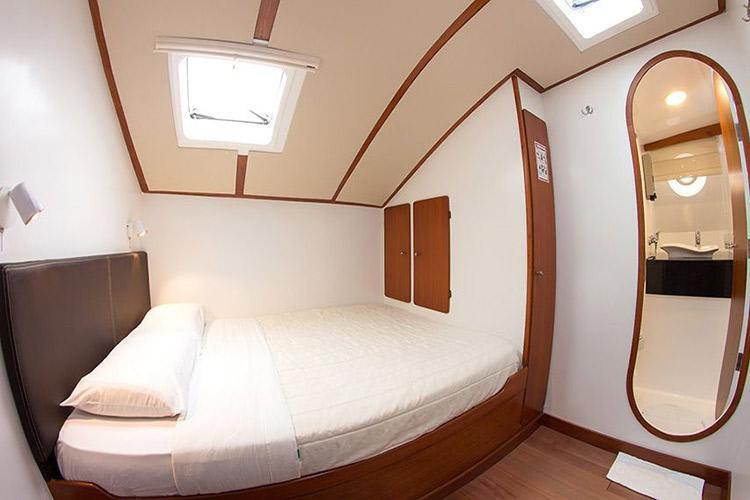
Superior Cabin
The cabins are air-conditioned and furnished with a drawer and a cupboard to ensure you can fit items. The cabin comes with an ensuite bathroom equipped with hot water, a wet-room style shower, and a toilet. The windows are small skylights allowing in natural light. Cabins #1 & #2 have a double bed, while Cabins #3 & #4 can also have an additional bed for a third person and Cabin #5 features a bunk bed for two people.
Related Cruises
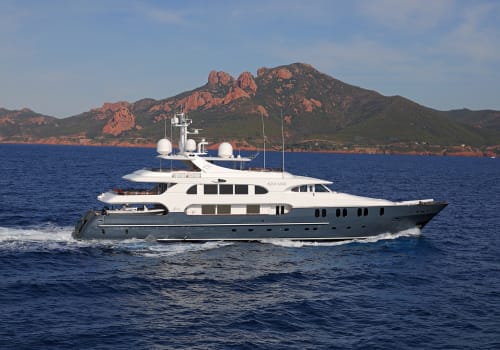
- Galapagos
- Ecuador
Aqua Mare

- Galapagos
- Ecuador
Cormorant II
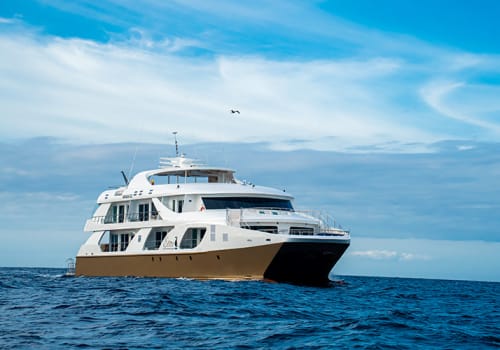
- Galapagos
- Ecuador
Elite

- Galapagos
- Ecuador
Galaxy Sirius
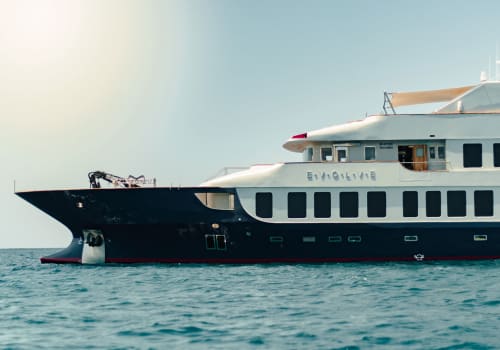
- Galapagos
- Ecuador
Origin, Theory & Evolve
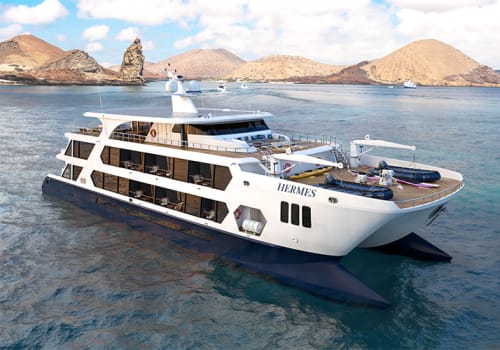
- Galapagos
- Ecuador
Hermes
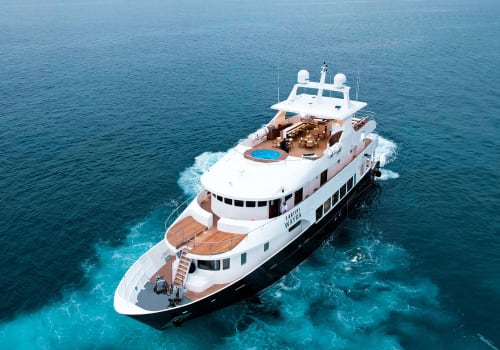
- Ecuador
- Costa Rica
Kontiki Wayra
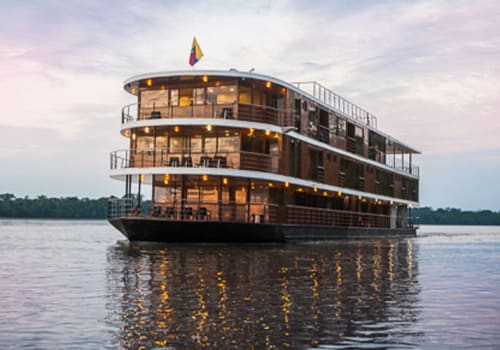
- Amazon
- Ecuador
Anakonda
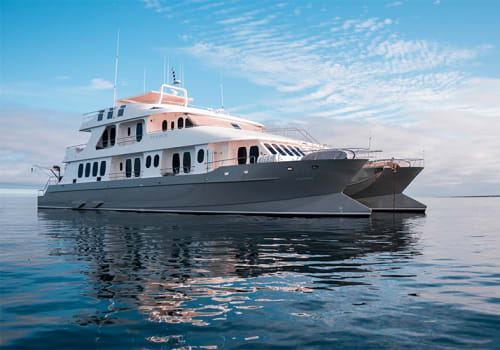
- Galapagos
- Ecuador
Alya
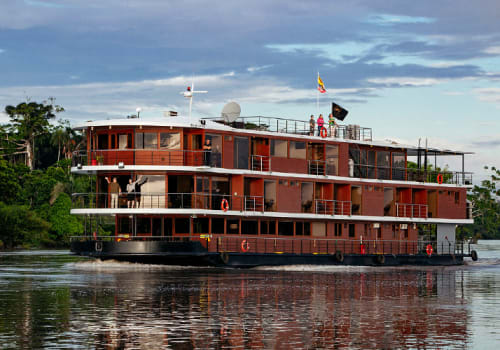
- Amazon
- Ecuador
Manatee Amazon Explorer

- Galapagos
- Ecuador
Endemic
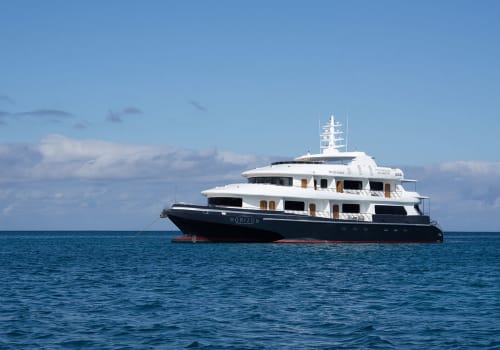
- Galapagos
- Ecuador
Galapagos Horizon
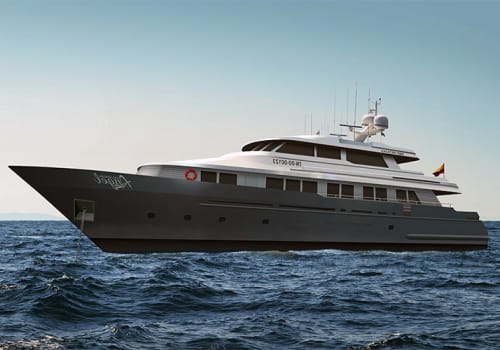
- Galapagos
- Ecuador

